|
"Dear
Son of
Memory,
Shakespeare's House,
Great
Heir of
Fame."
Stratford-on-Avon.
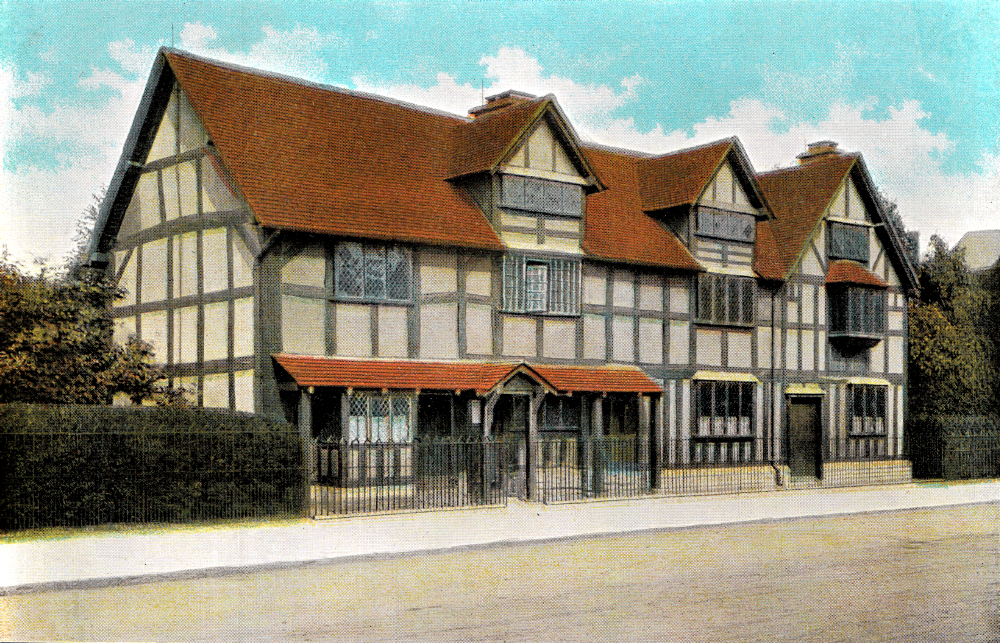
SHAKESPEARE'S HOUSE,
STRATFORD-ON-AVON.--The birthplace of England's greatest poet and dramatistthe
shrine to which the cultured, the scholarly peoples of the earth count it their
happy privilege to make a pilgrimage. To visit the haunts, and enjoy the simple
beauty which surrounded the immortal bard, conjures up in imagination the
visions and fancies to which he gave such exquisite expression. We pass with
awe within the portals as though the spirit of the dead were there, and wander
through the heavy oak-beamed apartments with the proud realisation this was
the home of Shakespeare.
|
Original |
|
Birthroom of Shakespeare,
Stratford-on-Avon.
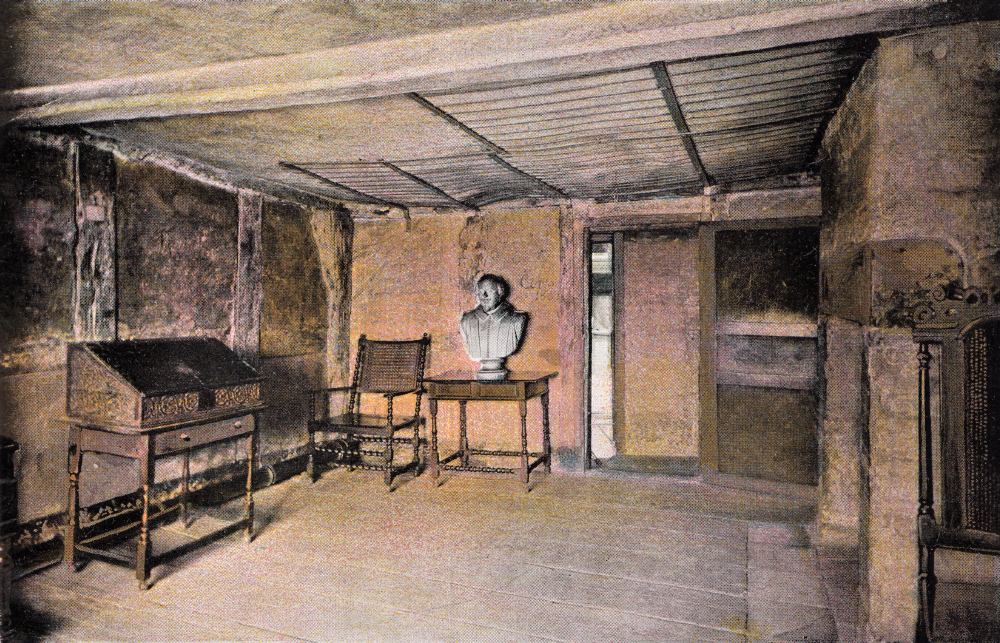
BIRTHROOM OF
SHAKESPEARE, STRATFORD-ON-AVON. Leading from the lower floor is a solid oak
staircase of ten steps, by which we enter the above apartment. The huge oaken
beams projecting from the walls look as enduring as the poet's fame. There is
an intangible something here which attracts and fascinates: we imagine the babe of 1575,
who was destined to immortal fame and
honour, which brings the world in admiration
to his shrine as century succeeds century. The web of autographs on every available space testifies to
unnumbered pilgrims.
|
Original
|
"Nothing can cover his high
fame but heaven;
Holy Trinity Church
No pyramids set off his
memories".
Stratford-on-Avon.
Beaumont and
Fletcher.
HOLY TRINITY CHURCH,
STRATFORD-ON-AVON. It would have been difficult to have found a more peaceful
haven of rest for the remains of the illustrious poet than this noble edifice
on the banks of the Avon, its spire rising from a mass of foliage. On entering
the sacred building we become impressed with the Shakespearian atmosphere which
seems to pervade the place as we gaze on the tomb and memorial of the dead,
read the record of his baptism and death, and turn to the beautiful stained
glass window representing "The Seven Ages of Man."
|
Original
|
|
"The good
and great one, passed away,
Shakespeare Memorial Theatre
Has
worshippers still o'er his soulless
clay."
Stratford-on-Avon.
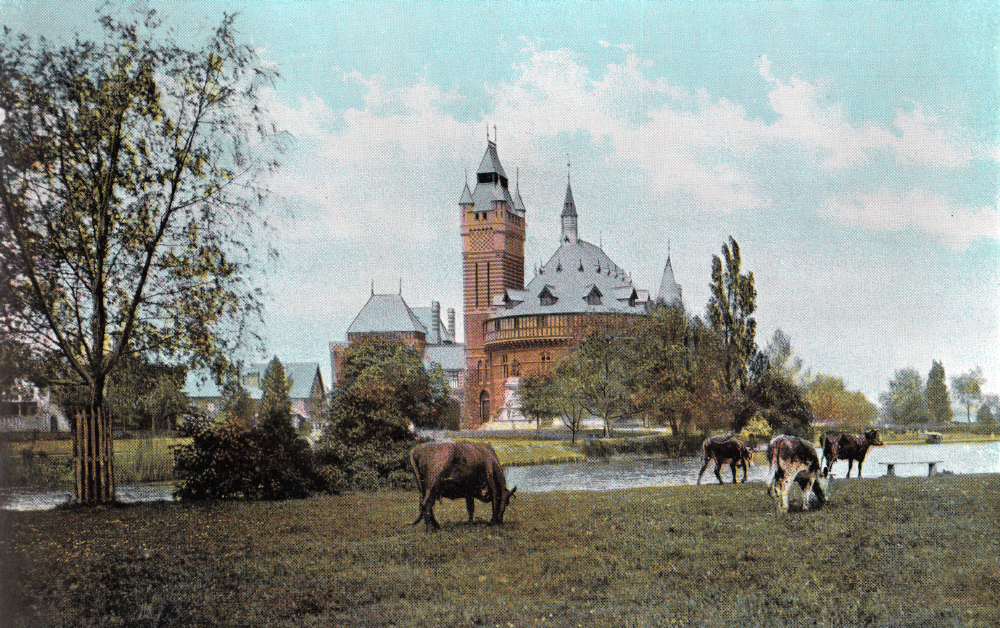
SHAKESPEARE MEMORIAL THEATRE,
STRATFORD-ON-AVON. This fine modern building is another eloquent tribute of
admiration to the memory of Shakespeare, for his birth is annually celebrated
here by dramatic representations from the great author's plays. There is a
Library and Picture Gallery attached, in which a goodly collection of things
Shakespearian has accumulated, and in the grounds a handsome monument stands,
representing the great dramatist, surrounded by figures in bronze of Hamlet,
Falstaff, Henry V., and Lady Macbeth. No more characteristic grouping could
have been conceived.
|
Original
|
|
"Chief
Prompter on Creation's stage,
American Memorial
Our endless joy our
matchless pride."
Stratford-on-Avon
Eliza Cook.
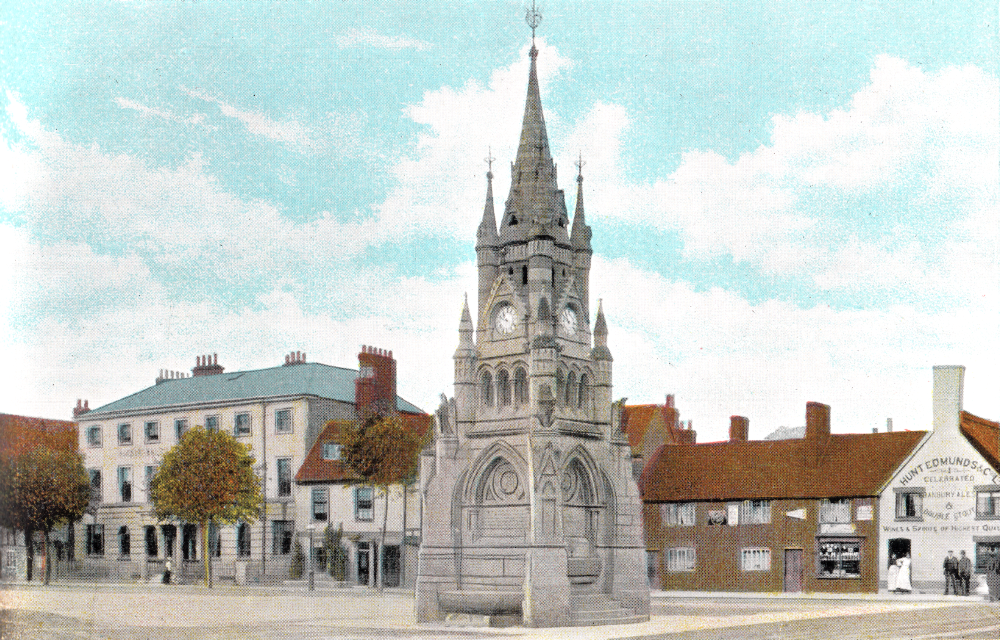
AMERICAN MEMORIAL,
STRATFORD-ON-AVON. Our cousins across the sea have always held in deep
veneration the memory of Shakespeare, and this handsome Clock Tower and
Fountain, standing in the Rother Market, was "The gift of an American Citizen,
George W. Childs, of Philadelphia, to the town of Shakespeare, in the Jubilee
Year of Queen Victoria." There is also inscribed the following quotation
from Washing-ton Irving's "Stratford-on-Avon ": "Ten thousand
honours and blessings on the Bard who has gilded the dull realities of life
with innocent illusions."
|
Original
|
|
It brings the haunts of childhood's clays, Guild
Chapel,
Grammar School, and Alms Houses
The
hours of sport,
the shouts of
mirth."
Stratford-on-Avon.
Eliza Cook.
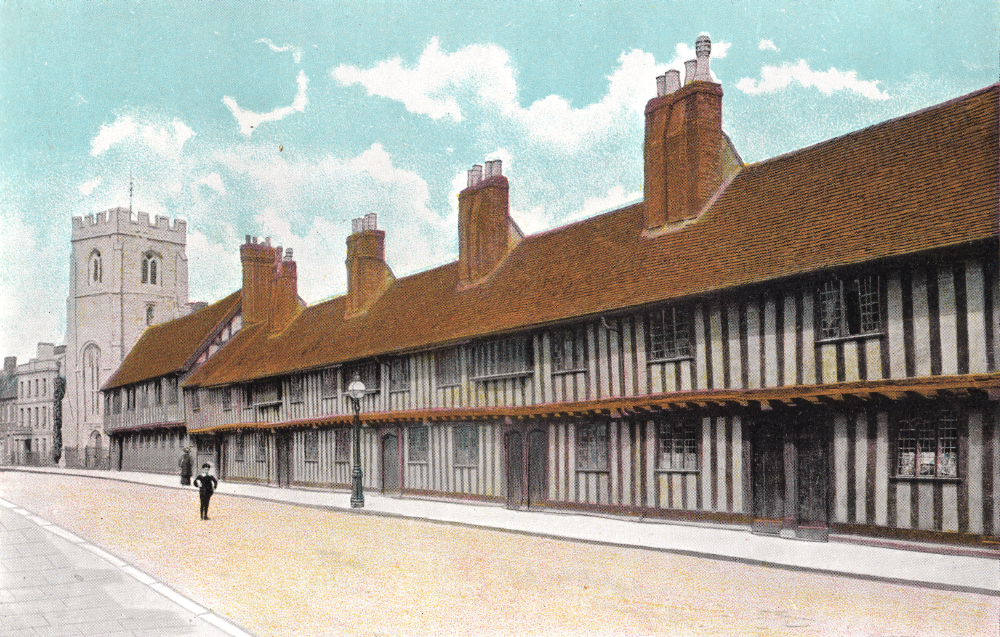
GUILD CHAPEL, GRAMMAR
SCHOOL, AND ALMS HOUSES, STRATFORD-ON-AVON.These old buildings are of great
antiquity and interest, for they include the Grammar School where Shakespeare
was educated. A quaint, old place
founded in the reign of Henry VI.round which one delights to linger,
for there is much that must be the same now as in the poet's school-days.
Adjoining the school is the crumbling old Gothic pile known as the Chapel of
the Guild of the Holy Cross and St. John the Baptist, and which must have been
very familiar to Shakespeare
|
Original
|
|
"Truth-teller! whose illumined page Anne Hathaway's Cottage.
Has never yet
been laid aside."
Eliza Cook.
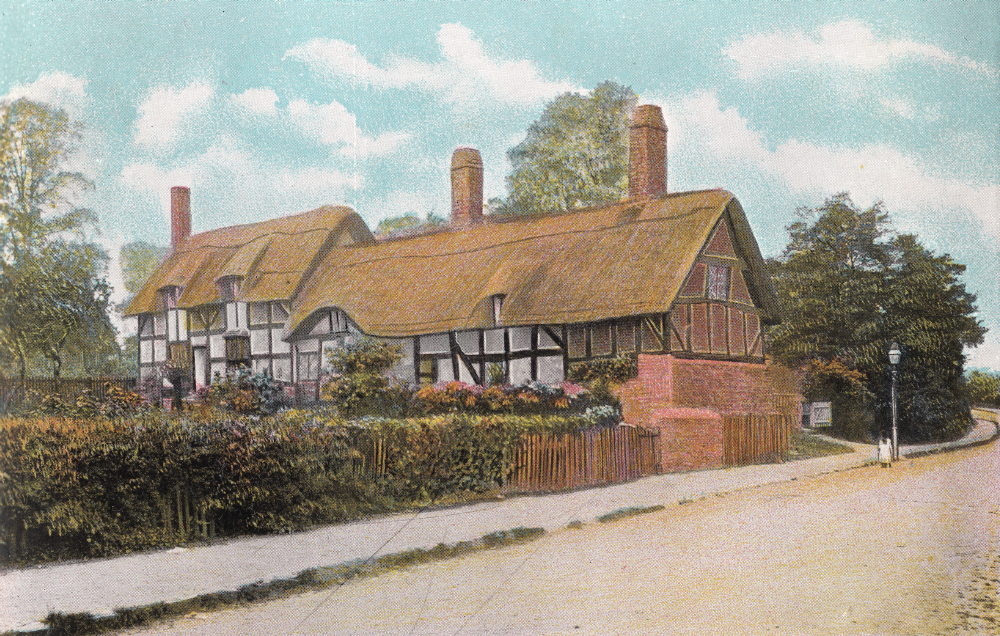
ANNE HATHAWAY'S
COTTAGE. Second only in interest to the famous birthplace of Shakespeare, is
the quaint-old-fashioned cottage, in which he wooed and won his wife. It stands
in the picturesque little village of Shottery, and is one of the rustic, thatch-roofed,
half-timber cottages characteristic of Warwickshire. It is at Shottery we may
think of the poet as other men are, for it was in the immediate district that
at a very early age he tasted the joys of domesticity, tempered by struggles
with comparative poverty.
|
Original
|
|
"Truth-teller!
whose illumined page Interior, Anne
Hathaway's Cottage.
Has never yet
been laid aside."
Eliza Cook.
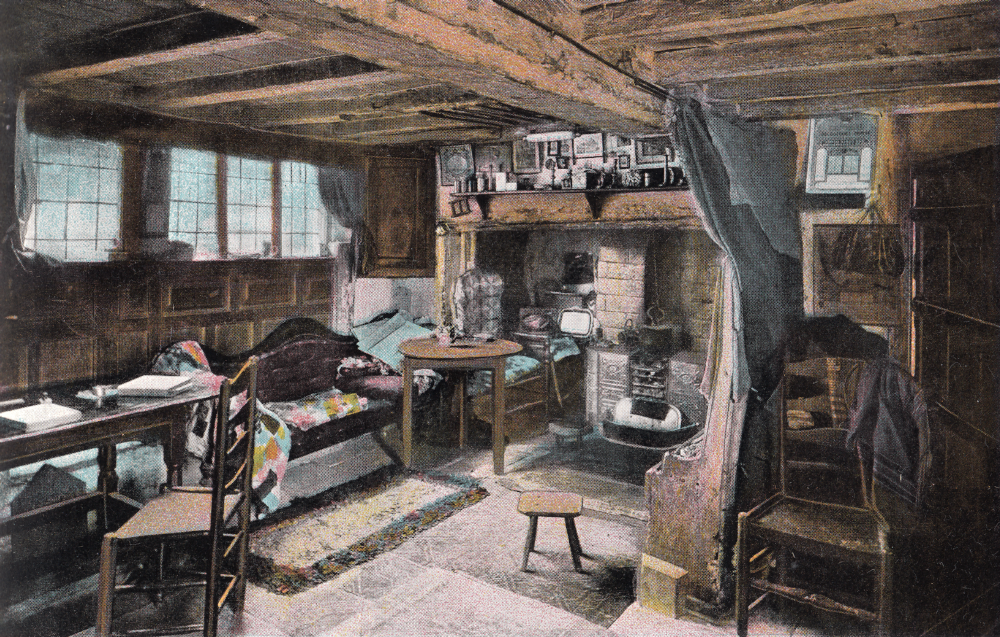
INTERIOR, ANNE
HATHAWAY'S COTTAGE.The inside of this quaint old cottage is very similar in
appearance to the interior of Shakespeare's house. It is characterised by low
roof, massive projecting beams of timber, and an old-fashioned chimney corner,
in which one can imagine Anne seated at workperhaps on the open-work
pillow-case, and sheet marked " E.H.," still kept in a chest in the
bedroom above, which also contains an elaborately carved bedstead, certainly
old enough to have been used by the Hathaway family. It is an interesting
heirloom, handed down with the house.
|
Original
|
|
High Street,
Stratford-on-Avon.
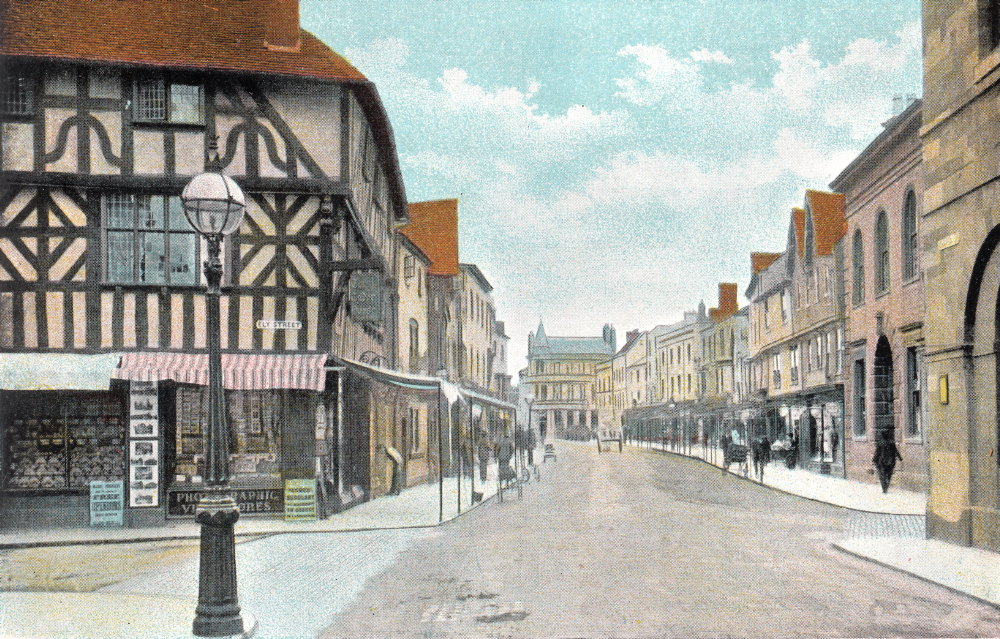
HIGH STREET,
STRATFORD-ON-AVON. What memories arise when traversing this fine street, so
spic and span, so rich in antique architecture, so closely associated with the
lives of great men. Here we have the noble Tudor House, quaintly picturesque
with its heavily-timbered projecting front, and not less interesting interior.
A little further on is Harvard House, formerly the home of the founder of
America's greatest University, and to whom the Archbishop of Canterbury
referred as "Gossamer slight, but not gossamer weak, is this link between
America and England." Almost opposite is the famous Shakespeare Hostelrie.
|
Original
|
|
The Five Gables,
Stratford-on-Avon
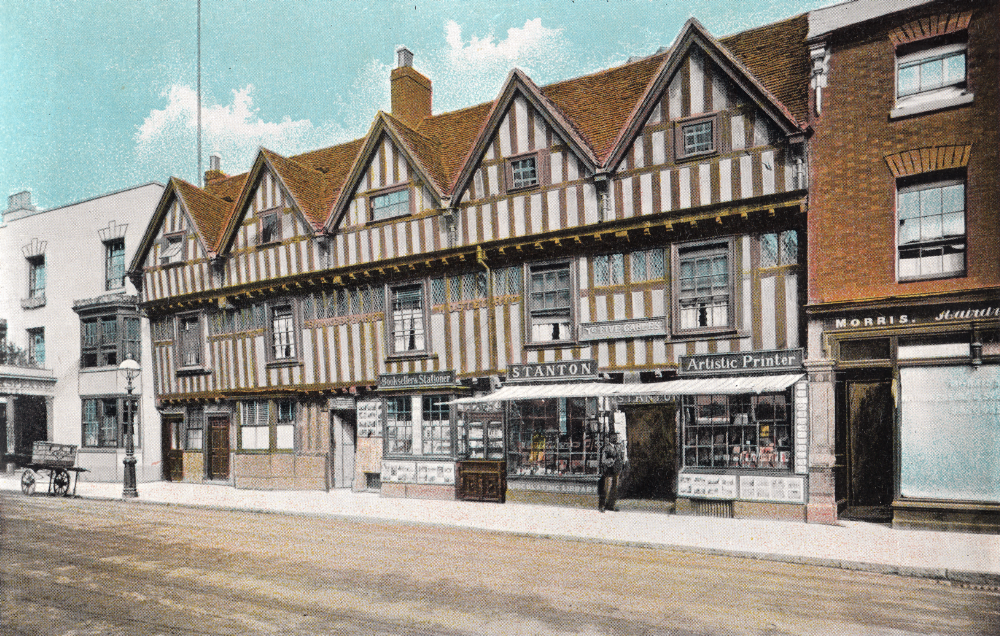
THE FIVE GABLES,
STRATFORD-ON-AVON. Our subject is another example of the quaint architecture
of the Shakespearian era, and its fine gables and heavily-timbered frontage is
a picturesque feature of Chapel Street. Adjoining is the commodious Shakespeare
Hotel, and its five gables bear the title of "The Shakespeare
Hostelrie," while in close proximity is New Place, the home of the poet in
the later years of his life, when success had been achieved, and there he
composed many of the dramas which enrich the world to-day.
|
Original
|
|
Mason Croft,
Stratford-on-Avon.
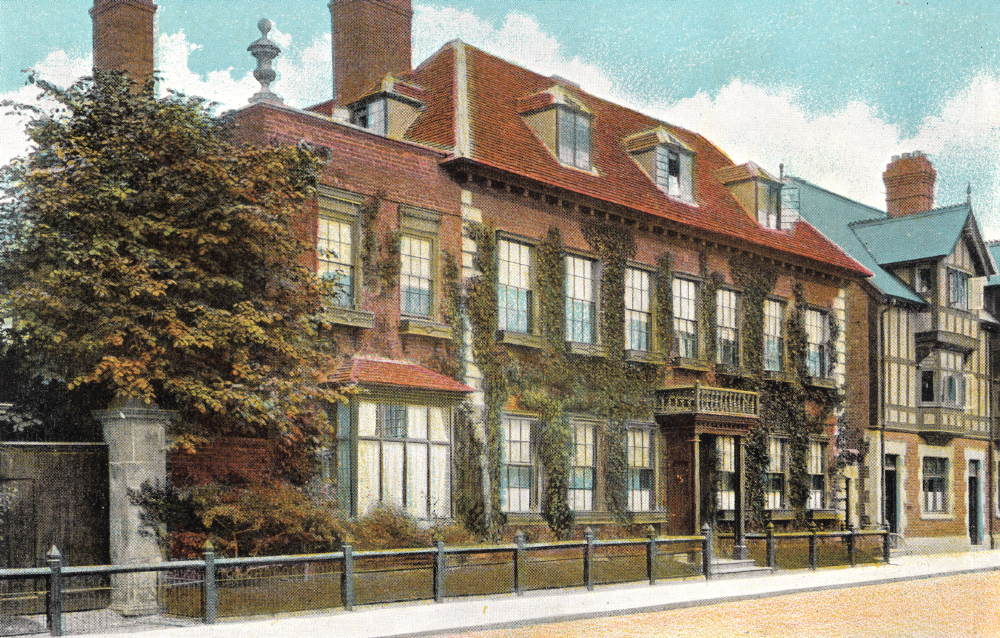
MASON CROFT,
STRATFORD-ON-AVON. After ruminating on so many connecting links of the past,
we are somewhat vividly brought back to our own time when viewing the residence
of Miss Marie Corelli. One can imagine the quiet peaceful atmosphere of
Stratford conducive to the noble life of John Walden, ideally depicted in
"God's Good Man," but the advent of "Free Opinions" leads
one to suppose there is great need for many such living examples. Miss Corelli
has been enthusiastic in keeping the Shakespearian town in its quaint
picturesqueness.
|
Original
|
|
"The pensive willows stoop to kiss
Bancroft Gardens,
The stream so deep and clear."
Stratford-on-Avon.
Eliza
Cook
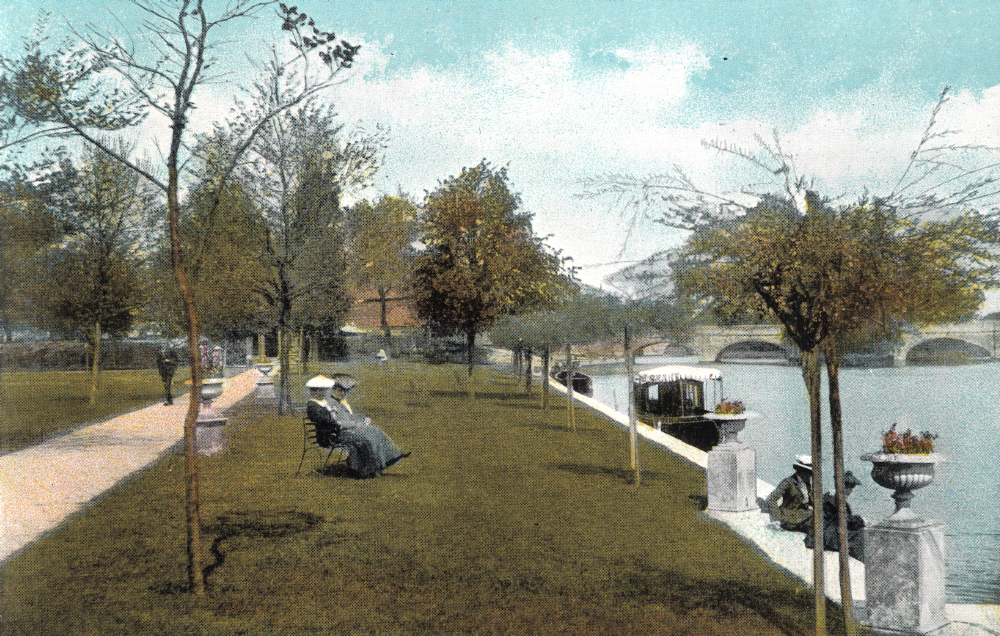
BANCROFT GARDENS, STRATFORD-ON-AVON. This is an
exceedingly pleasant open space on the banks of the Avon, which broadens
considerably as the bridge is approached. Here boating is in full vogue, and
one may embark in the languorous eventide, and glide down the silvery waterway,
disturbing the shadows and reflections where the willows kiss the waters, and
explore the beauties of the river, or drift past the Shakespeare Theatre to
where the stately, swaying elms, surround the Church in which the remains of
our immortal bard repose.
|
Original |
|
Royal Pump Rooms,
Leamington.
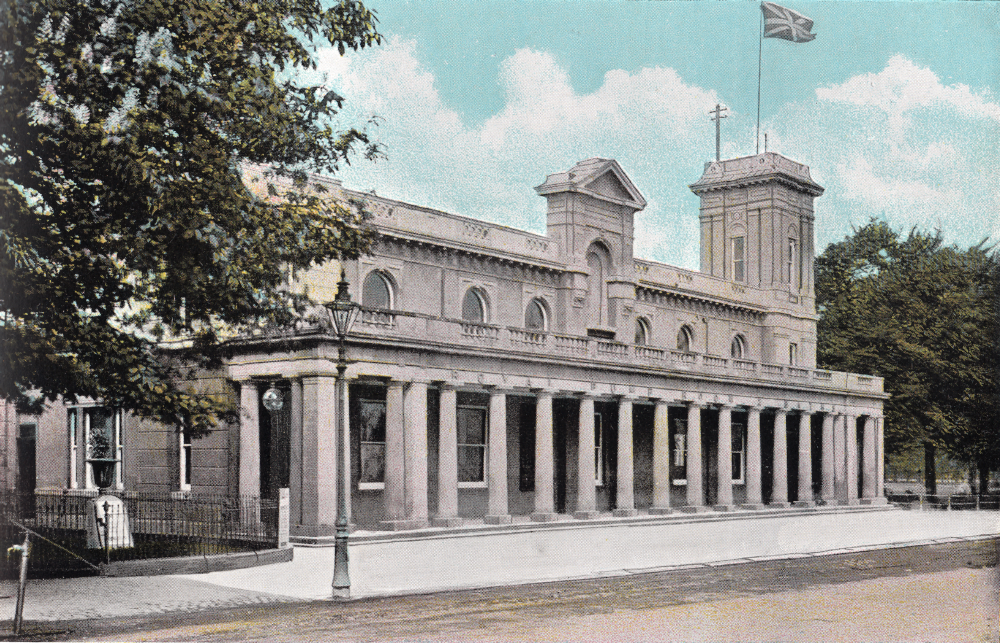
ROYAL PUMP ROOMS, LEAMINGTON.There is no doubt
many of the springs were discovered long before their commercial value was
taken advantage of, for we are told by Camden in 1536, the Canons of Kenilworth
Priory "found here a spring of infinite medicinal power," while it
was nearly 300 years later their valuable properties were made more widely
known by Abbotts and Satchwell. Immediately the town grew by leaps and bounds,
and in 1808 Pump Rooms were erected, and Leamington quickly became the
fashionable inland watering-place it is to-day.
|
Original |
|
Victoria Bridge,
Leamington.
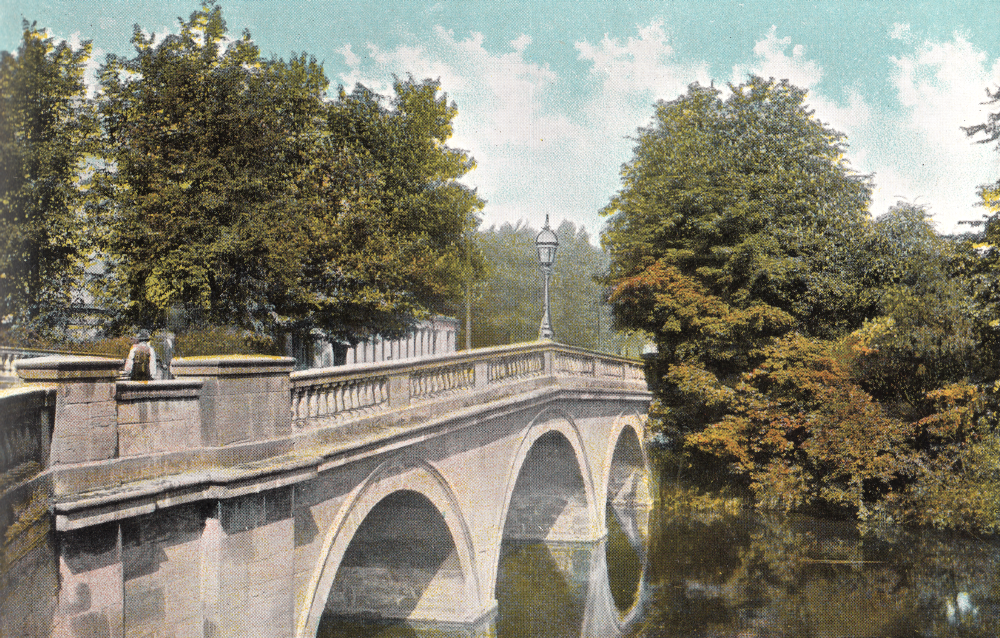
VICTORIA BRIDGE, LEAMINGTON.In
contradistinction to its near neighbours, Leamington is essentially a modern
town, and may claim to be one of England's foremost inland health resorts. Here
we reproduce a handsome stone bridge, under which the Learn pursues its silent
course, and in crossing, a very pleasing view is presented of over-hanging
trees, a rushing weir, and suspension bridge. Viewing the splendid Parade, the
Town Hall, in Renaissance style, and other architectural features, it is
difficult to realise that a comparatively short time back the town was known as
Leamington Priors, and the chief building was a tiny thatched church.
|
Original |
Willes' Bridge,
Leamington.
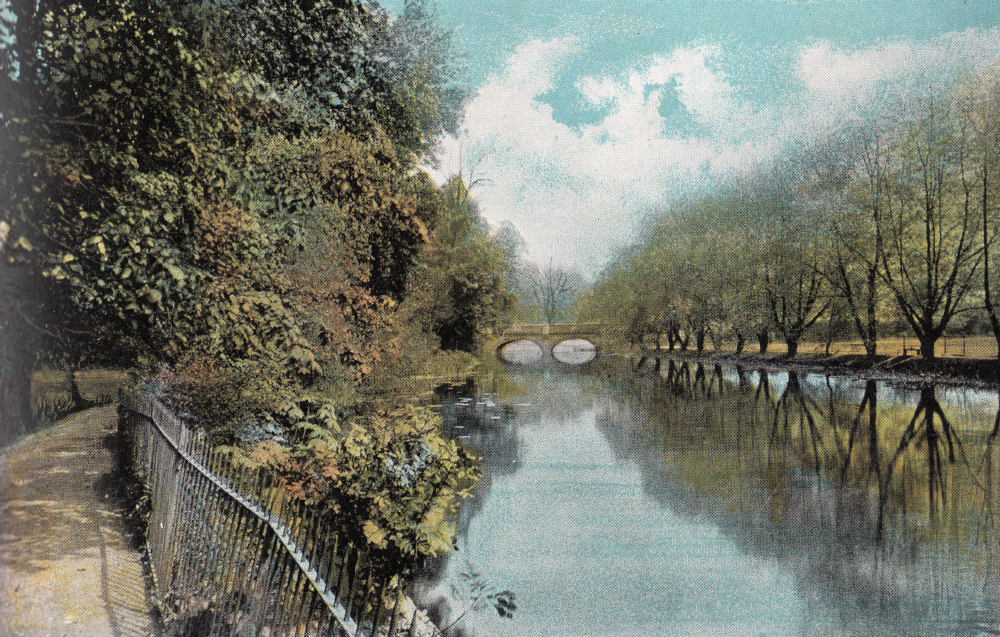
WILLES' BRIDGE, LEAMINGTON. This
lovely river scene, which opens out to one from the Jephson Gardens, might well
be called "Reflections." It shows the Learn dressed in the beauties
of spring, and a pull up the river, under the bridge, past woodland and
pasture-land, with cattle lazily browsing thereon, is well rewarded, for at
every bend a picturesque view is disclosed, while the overhanging willows,
reflecting their rich foliage in the watery mirror, form a delightfully cool
natural archway. The wild duck is also seen here in plenty.
|
Original
|
Jephson Gardens,
Leamington.
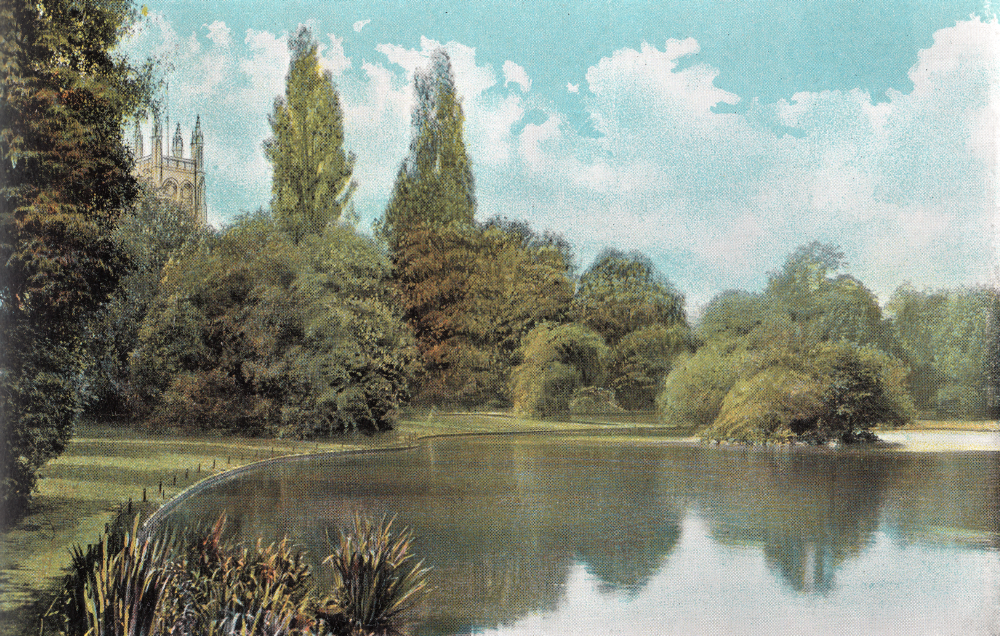
JEPHSON GARDENS, LEAMINGTON. The
lake is the home of gold and silver fish and ducks; it is a pretty sheet of
water, surrounded by trees through the tops of which the tower of the parish
church is peeping. A stroll round the grounds discloses a small temple,
containing a marble statue of Dr. Jephson, whose skill helped in no small
degree to bring Leamington into such high repute. Another tribute to
beneficence is an obelisk of granite to the memory of Edward Willes, Esq., who
gave the land for the gardens; and there is a handsome fountain known as the
Hitchman Memorial.
|
Original |
|
"These
happy walks and
shades."
Jephson Gardens,
Milton.
Leamington.
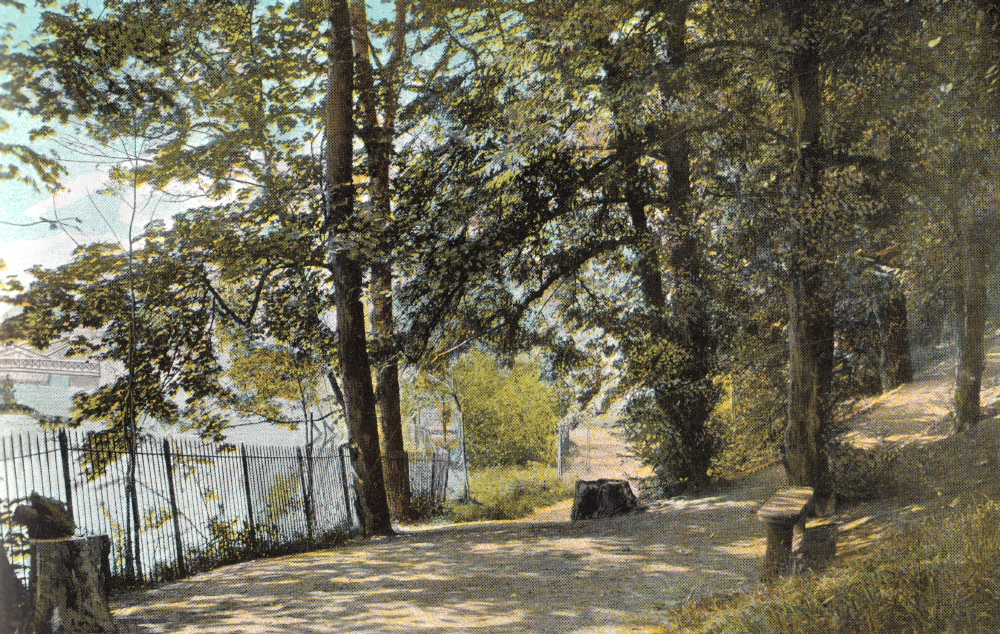
JEPHSON GARDENS, LEAMINGTON. These
beautiful gardens form a delightful retreat from the heat and rush of town
life, and we reproduce above one of those shady glades so fascinating to
"the toilers from the city." Here one may rest awhile and watch the shadows play upon the
parted ways, the graceful glidings to
and fro of the swans on the water lying below, while the more vigorously inclined may wend
their way to the tennis courts, archery ground, or the intricate maze. Through
this pleasing vista the Suspension Bridge may be seen on the left.
|
Original |
Pump Room Gardens
Leamington.
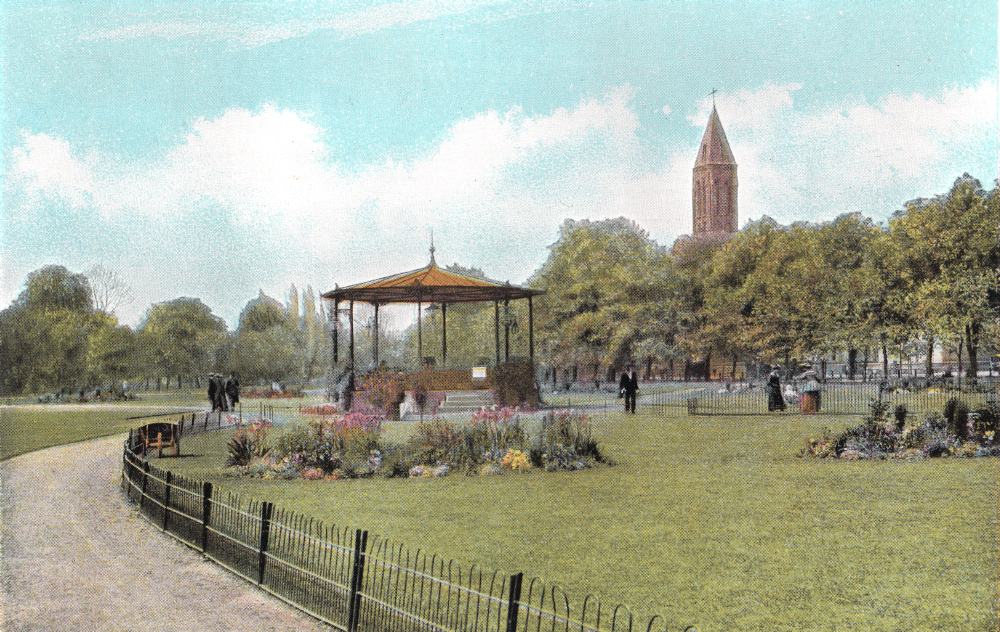
PUMP Room GARDENS, LEAMINGTON. One of the favourite promenades of
visitors--tastefully laid out with flower-beds, bounded on three sides by
avenues of fine trees, it forms a fine enclosure. Here one can stroll in the
evening and enjoy the music and the sweet balmy air, for which the Royal Spa is
well known. The town is appropriately named "Leafy Leamington," for
it is more like a garden, streets and squares being lined with sweet-scented
limes, shady elms and chestnuts, and foliage and flowers meet the eye
everywhere.
|
Original |
|
"These
happy walks and
shades."
Jephson Gardens,
Milton.
Leamington.
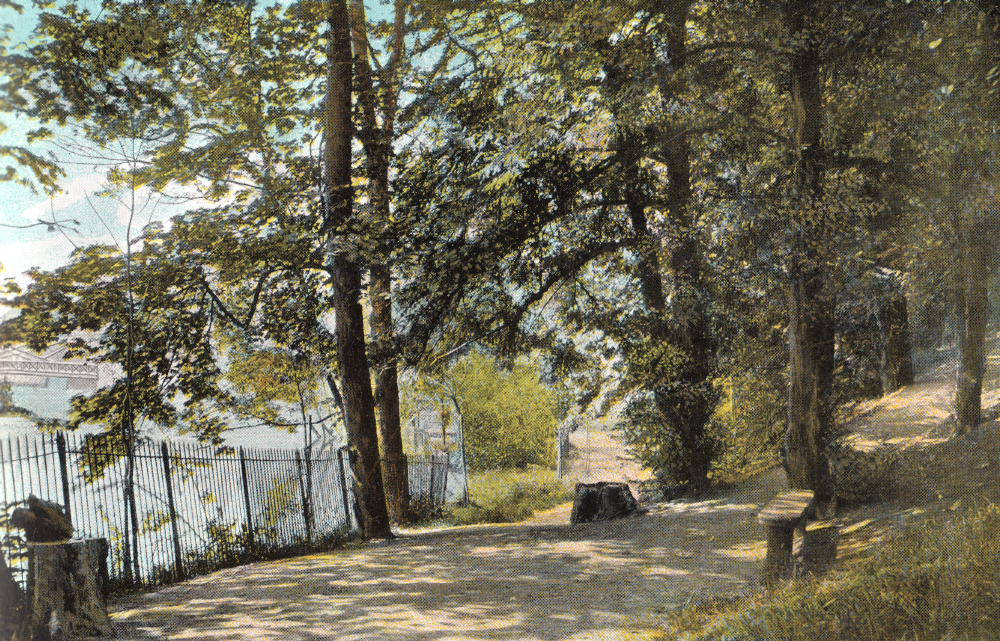
JEPHSON GARDENS, LEAMINGTON. These
beautiful gardens form a delightful retreat from the heat and rush of town
life, and we reproduce above one of those shady glades so fascinating to
"the toilers from the city." Here one may rest awhile and watch the
shadows play upon the parted ways, the graceful glidings to and fro of the
swans on the water lying below, while the more vigorously inclined may wend
their way to the tennis courts, archery ground, or the intricate maze. Through
this pleasing vista the Suspension Bridge may be seen on the left.
|
Original |
New River Walk,
Leamington.
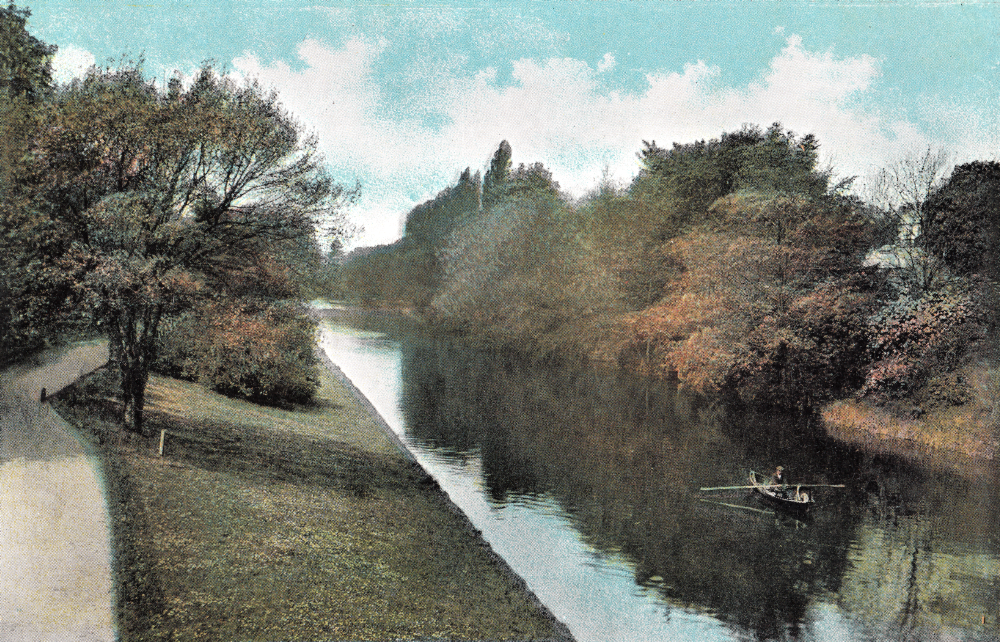
NEW RIVER WALK, LEAMINGTON.--Extending
nearly a mile by the River Learn, the well-kept footpath beneath an avenue of
sheltering trees, with grassy bank sloping gently to the water, forms an ideal
riverside walk from Adelaide Bridge to the Weir. If a row or paddle is desired,
the facilities are at hand, and gliding along on the shimmering surface below
the over-hanging trees, will be found delightful, or a boat may be hired at
Emscote, and a pull up river to Warwick Castle will bring its own reward.
|
Original |
York Walk,
Leamington
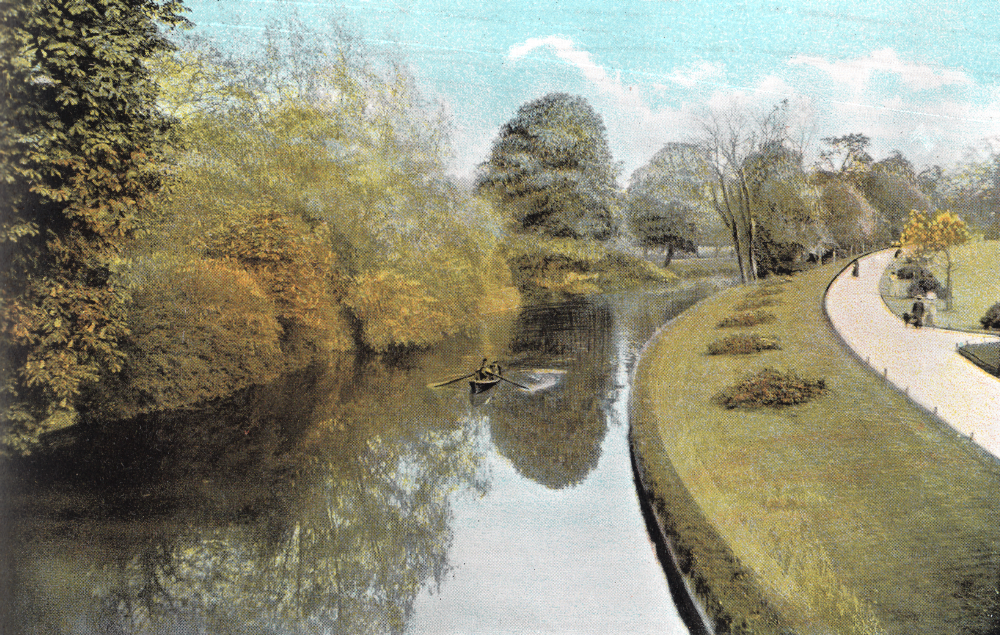
YORK WALK, LEAMINGTON, Rich in
promenades, leafy avenues, and gardens, the Royal Spa makes a desirable holiday
resort in the diversity of its entertainments and recreations. In the gardens,
delightful walks, tennis, and promenade al fresco concerts please many, while
the Avon affords good sport to anglers and the boating fraternity. Leamington
is greatly indebted to Dr. Jephson in securing to the town such attractive open
spaces, where one may retreat from the heat and toil of the day, and find
health and strength without being bored in the finding!
|
Original |
Clarendon Square,
Leamington.
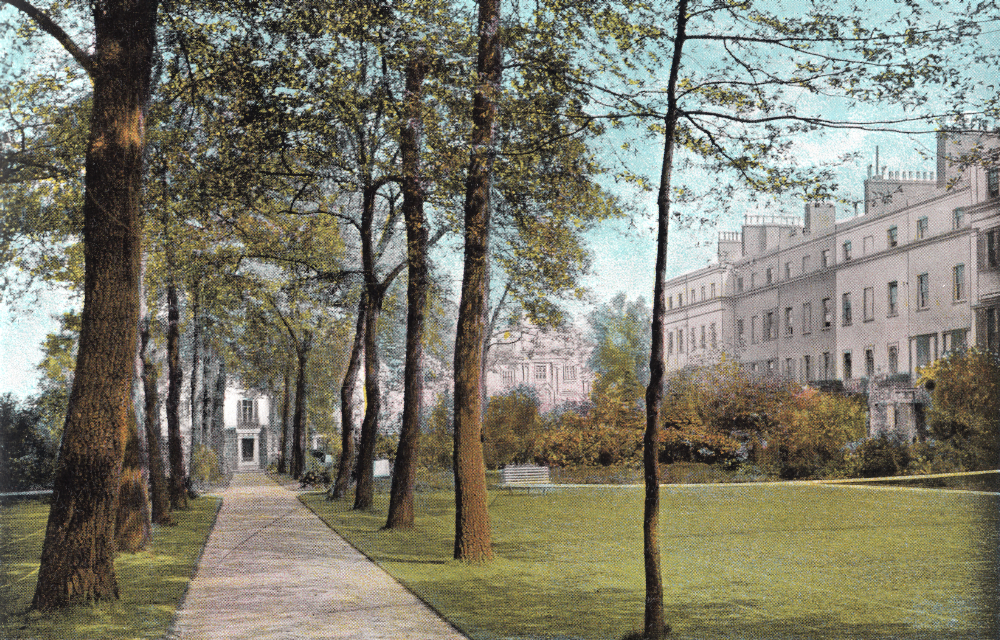
CLARENDON SQUARE, LEAMINGTON. There
is no doubt that Leamington forms one of the most delightful residential towns
in England. It is not only central and well served with travelling facilities,
but when Warwick Castle, Stratford-on-Avon, and Edgehill are mentioned, it will
also be recognised as the hub around which history has been made in past ages,
and while the body may be invigorated and refreshed by the balmy air and
pleasing tree-lined streets and squares, the mind may be enriched by the
historical associations found in the vicinity.
|
Original |
Parish Church,
Leamington.
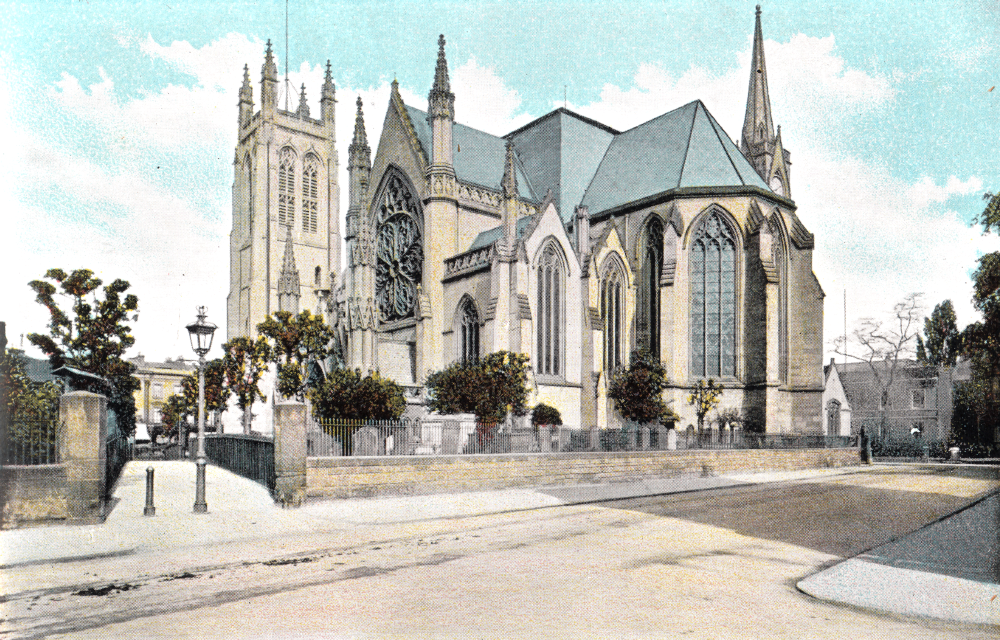
PARISH CHURCH, LEAMINGTON. Nothing has been spared to make this handsome
edifice worthy of its object and an ornament to the town. It is rich in
beautifully carved stone- work, elaborate stained glass windows, and highly
decorated both inside and out. When strolling in the adjacent gardens, one may see
its handsome stone tower rising through vistas of trees. Close to the Church is
the original spring of medicinal water, spoken of by Camden, which we refer to
on another page Leamington was but a little rustic village then!
|
Original |
The Midland Oak,
Leamington.
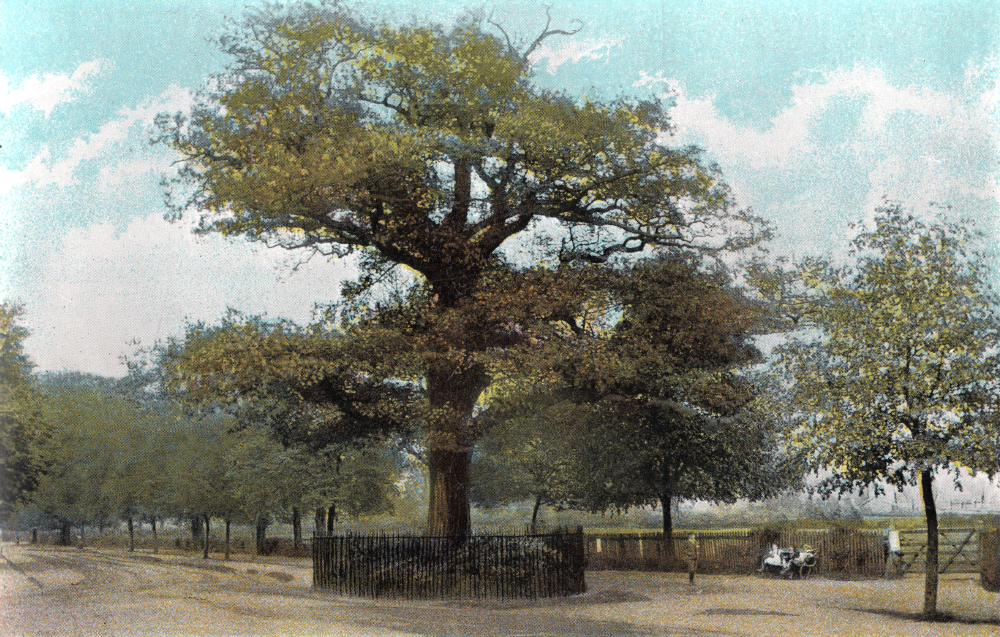
THE MIDLAND OAK, LEAMINGTON.--This fine old oak
tree is said to have been planted many years ago to mark the centre of England. Be this as it may, it certainly
forms the hub of a very charming
district, rich in historic surroundings, quaint
buildings, and interesting country, the latter studded with gems of
sylvan beauty. Nature has richly endowed the Royal riverside Spa, and it has been appropriately called
"a beautiful town in a beautiful
county."
|
Original |
|
"Our castle's strength
The Castle,
Will laugh a siege to scorn."
Warwick.
Shakespeare,
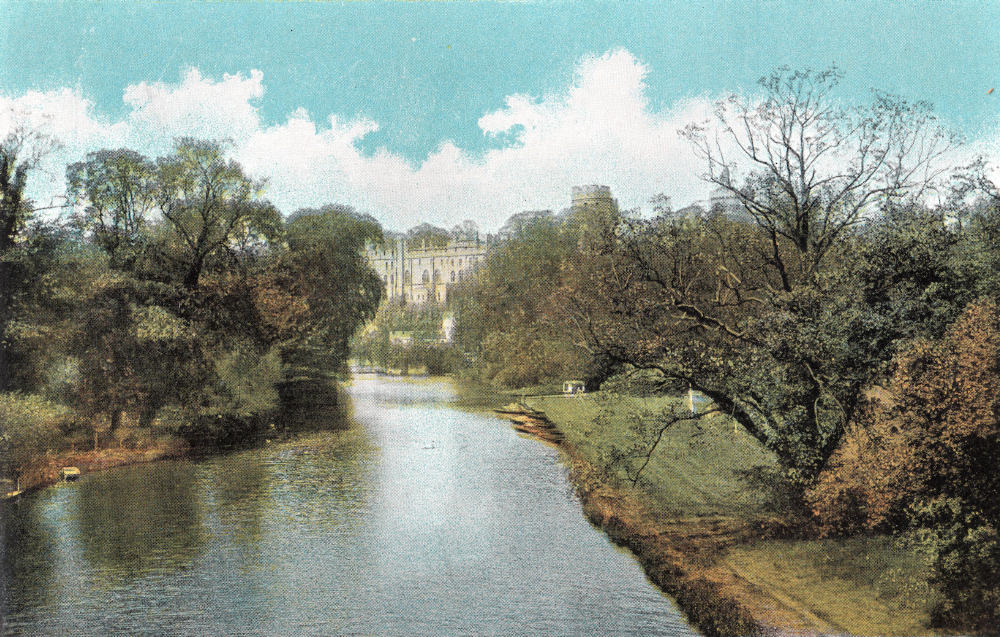
THE CASTLE, WARWICK. One cannot gaze on this
historical edifice without recalling the vicissitudes through which it has
passed, and the notabilities who have tarried there willingly and otherwise.
Ethelfleda, daughter of Alfred the Great, laid the foundation stone of the
Castle in 915. It was almost demolished by the Danes a century later. Our
delight at the charming view it affords changes to sympathy as we turn to the
massive towers, and contemplate the dismal dungeons and their unfortunate
occupants of the past, and we proceed to the more cheerful state rooms, filled
with an interesting collection of celebrated pictures, valuable antiquities and
curiosities, feeling glad we can visit the famous stronghold as a place of
beauty which links us to bygone ages.
|
Original |
Caesar's Tower,
Warwick.
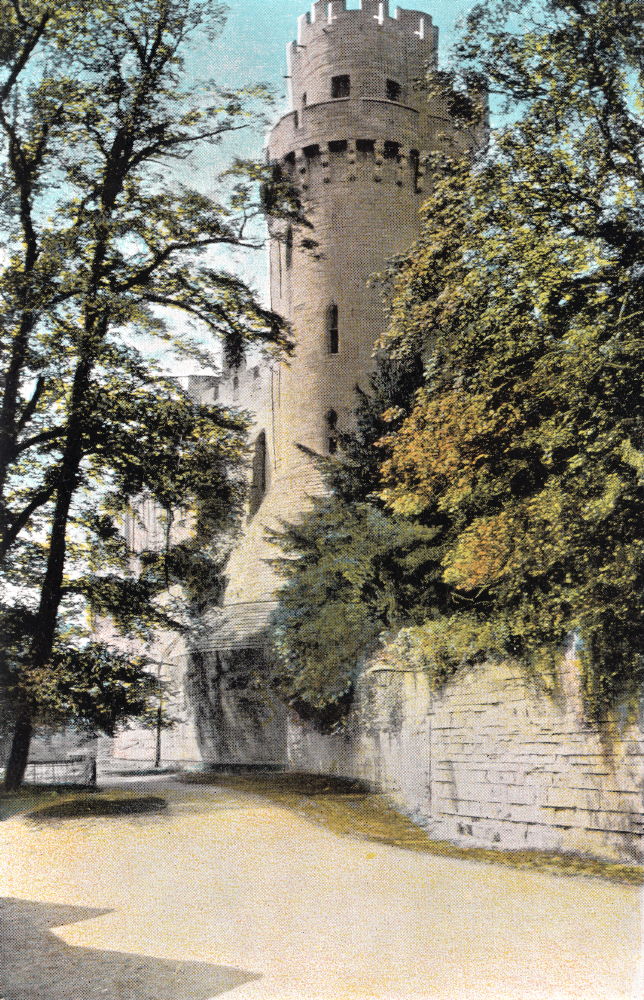
CAESAR'S TOWER, WARWICK. Our
subject is one of the stately towers,
which rise in bold magnificence at Warwick Castle, a visit to which is most
instructive and interesting. In the Great Hall is a collection of armour including a suit of horse trappings, said to have
belonged to Queen Elizabeth; while valuable paintings, rare and priceless
vases, antique gems, and works in marble, fill other apartments, in one of
which is the celebrated "Kenilworth Buffet," and scene from Sir
Walter Scott's novel will be recognised on the panels.
|
Original |
Leycester Hospital and
Westgate, Warwick.
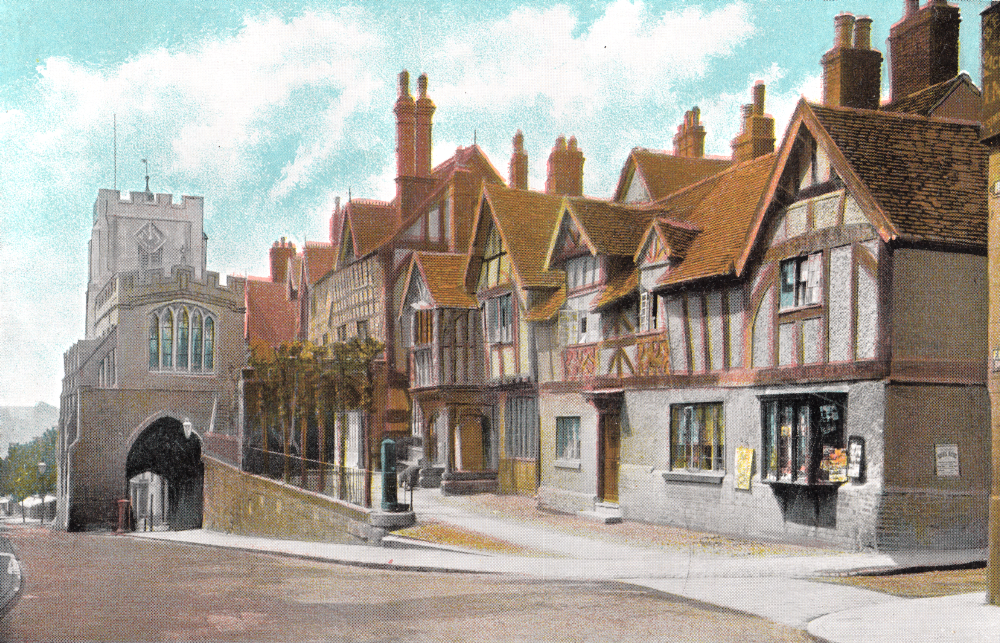
LEYCESTER HOSPITAL AND WESTGATE,
WARWICK. This is another exquisite example of the half-timbered, gabled, and
red-roofed style of architecture for which Warwickshire is justly famed, and
always extracts expressions of admiration from the visitor. The Westgate formed
the entrance to the western end of the once strongly fortified town, and the
Chapel of St. James, which surmounts it, is now used by the inmates of the
Hospital, which is occupied by a master and twelve brethren, according to the
statutes of its illustrious founder the Earl of Leycester in the reign of Queen
Elizabeth.
|
Original |
Mill Street,
Warwick.

MILL STREET, WARWICK. To walk here
must be a source of delight to the antiquarian. The fine gables and
heavily-timbered style of architecture take us back to the Middle Ages, while
its dignified surroundings make it doubly attractive, for at the top of the
street is the entrance to Warwick Castle, and at the bottom dwarfing the
cottages by its huge proportionsrises with impressive majesty Caesar's Tower,
at the base of which glides the River Avon the ever-moving and the immovable.
|
Original |
Near Warwick.
Guy's Cliffe House,
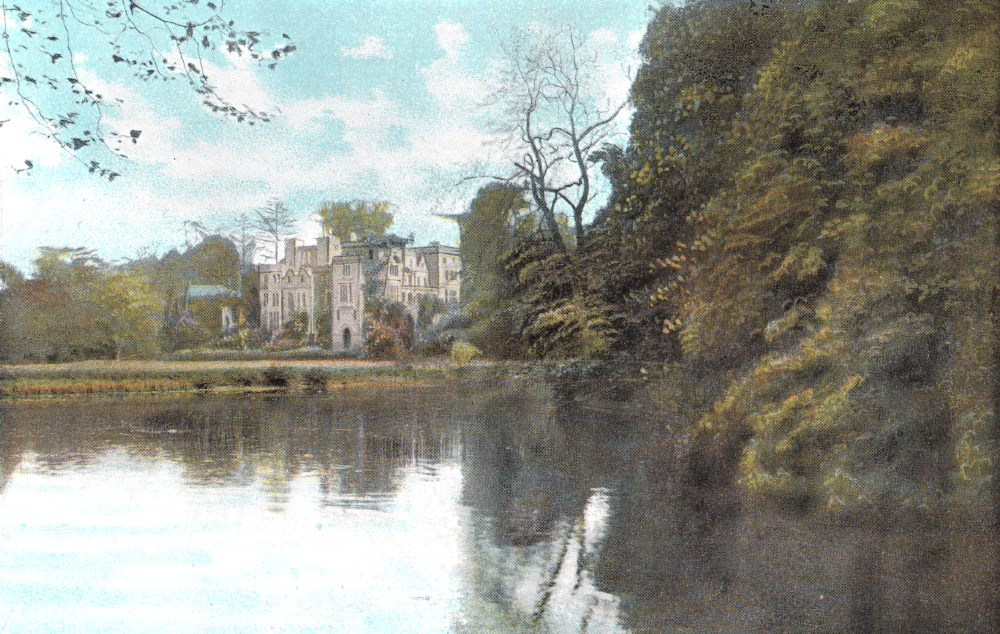
GUY'S CLIFFE HOUSE, NEAR WARWICK.
Most charmingly situated on the Avon.
The mansion was the residence of the redoubtable Guy, of whose prowess many
interesting stories are related. He was a veritable giant of immense height and
strength, and proved his courage in many a single combat with man and beast.
His adventures may be obtained in book form. In the later years of his life,
Guy lived in seclusion, and died here in 929. The estate is a very beautiful
one, and Guy's Cave should not be overlooked.
|
Original
|
Guy's Cliffe
Near Warwick.
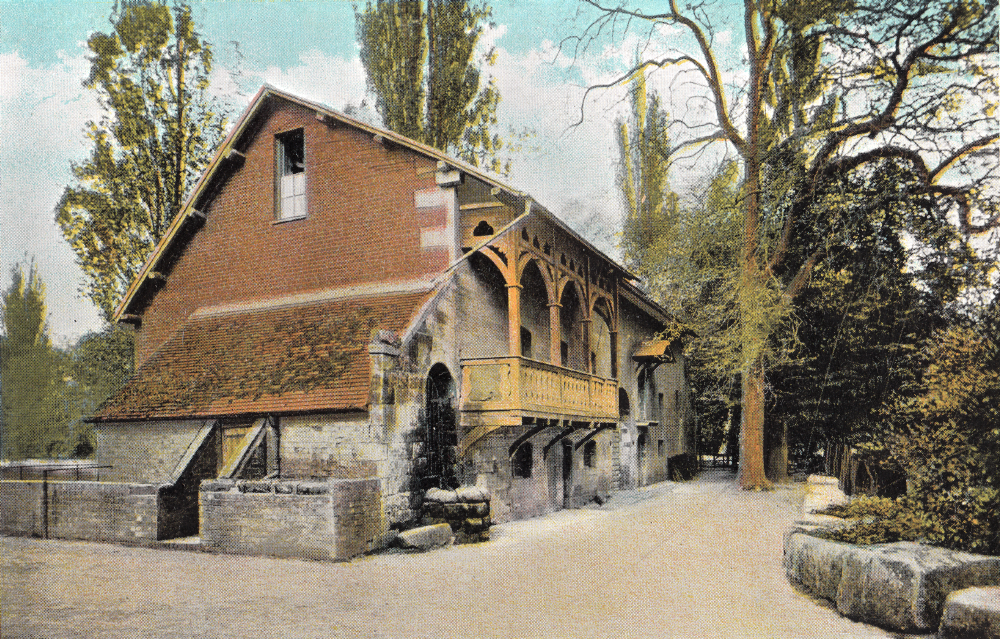
GUY'S CLIFFE MILL, NEAR WARWICK. .Never
will artists cease to transfer to canvas this picturesque spot, and the subject
well repays the effort. It stands exactly opposite Guy's Cliffe House, with the
river intervening, and at the further end is a rushing weir. The water-wheel at
work proves it not only a place of quaint beauty, but one of usefulness also.
From here it is a pleasant country walk or drive to Warwick, Leamington, or
Kenilworth, with pleasing surroundings on every hand.
|
Original |
|
"Here stands the victim
Banqueting Hall
There the proud betrayer."
Kenilworth.
The Wodman.
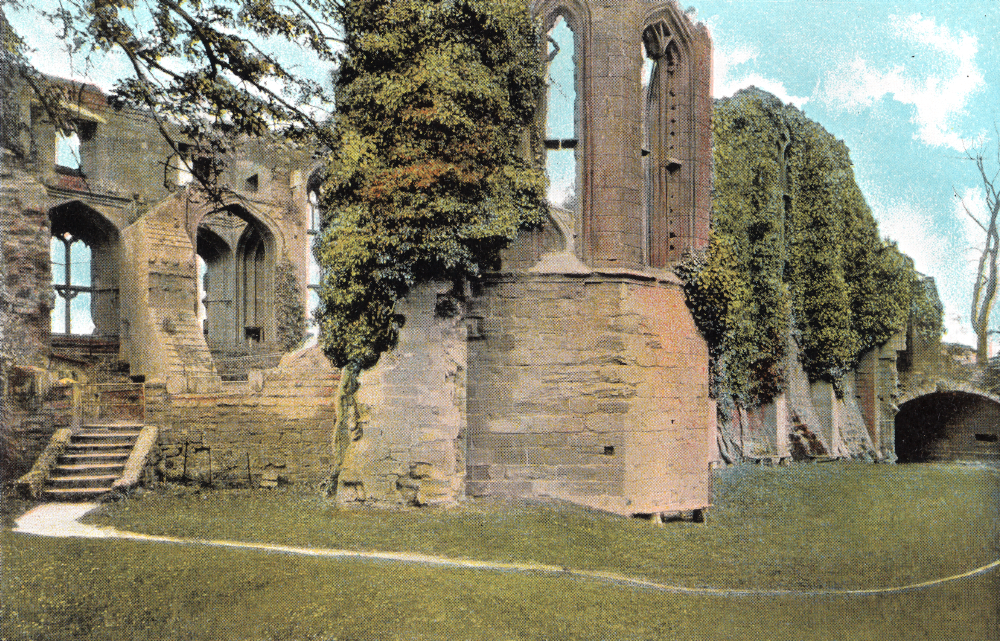
BANQUETING HALL, KENILWORTH. It
was here that Queen Elizabeth was entertained by her favourite, Dudley, in the
most lavish and magnificent style. It was in this hall that Sir Walter Scott,
in his novel "Kenilworth," places the scene of the tragic denouement
of Dudley exposing his perfidy and intriguing nature to Elizabeth on her visit
to him in 1575. It was on this occasion the author tells of the meeting of the
Queen with Amy Robsart in the grotto, who was concealed therein, anxiously
awaiting her husband in secret, whom she dare not approach in public, and
although this story is more romance than fact, it adds a halo of interest to
these stately ruins.
|
Original |
Porch to Great Hall,
Kenilworth.
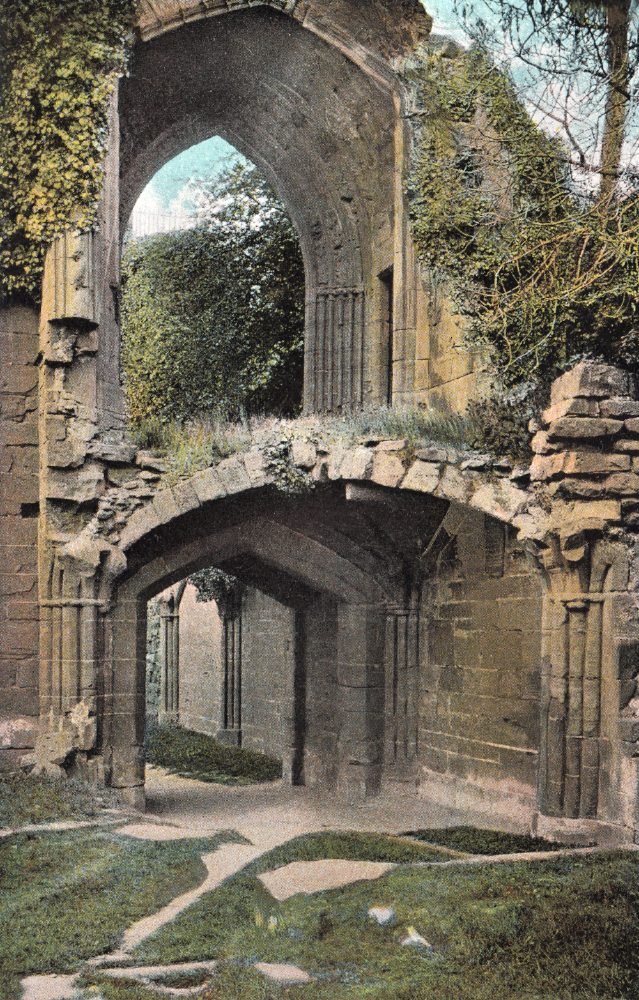
PORCH TO GREAT HALL, KENILWORTH. Ad join ing the Strong
Tower,
or "Mervyn's Bower," as Scott refers to it is this fine old porch, elaborately
panelled, vaulted, and groined. The floor of the Hall was formed by the roof of
an extensive vault underneath, and the hall itself must have been a magnificent apartment, containing many
fine windows. Entertainments of a most sumptuous character were given here,
music was discoursed front the Minstrel Gallery at one end, a State Throne occupied a dais at the
other, and the room was richly furnished.
|
Original |
The Keep,
Kenilworth.
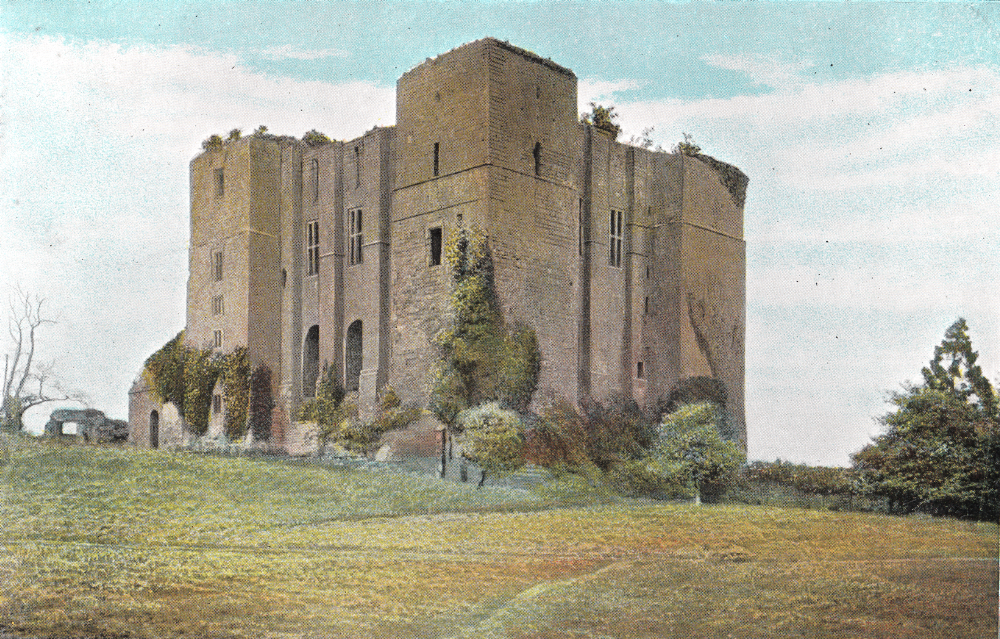
THE KEEP. KENILWORTH. This
frowning, rectangular pile, known as the Keep or Caesar's Tower, is a grand
specimen of military architecture, and dates back to the eleventh century. The
Castle has remained a ruin since it was dismantled during the Civil War. It has
belonged to many royal personages, and during the Barons' War sustained a siege
of six months, at which time it was occupied by Simon de Montfort, a man of
noble character, who fought and died in a glorious attempt to secure free
representative government for the country.
|
Original |
Leicester's Buildings,
Kenilworth.
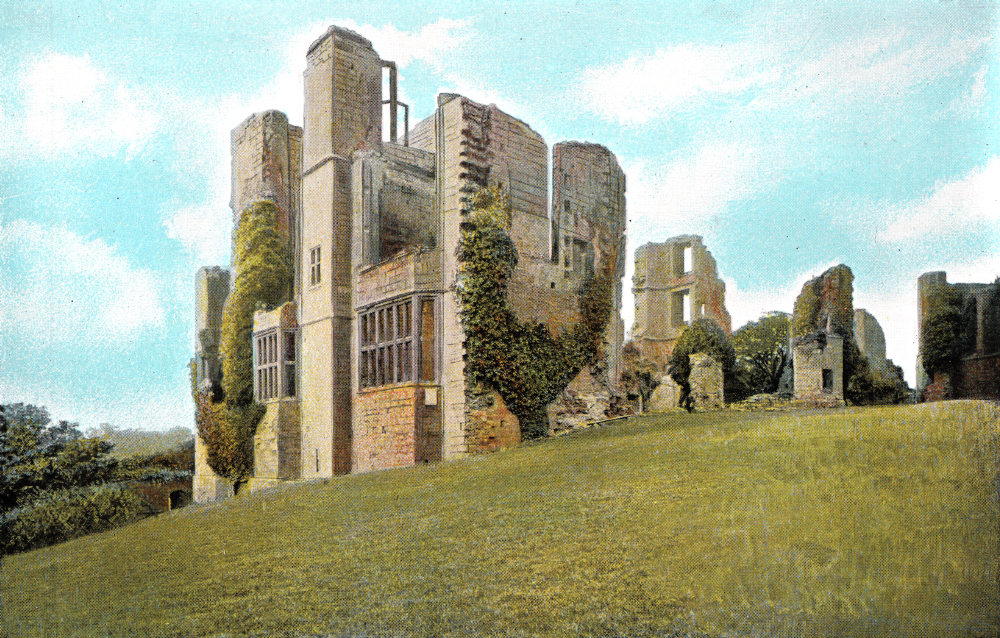
LEICESTER'S BUILDINGS, KENILWORTH.
What tragic scenes are brought to memory as these historic ruins are gazed
upon, which once sheltered Robert Dudley, Earl of Leicester, when in the zenith
of his fame. How interesting to linger and trace the various apartments, to
follow Sir Walter Scott's narrative of history and romance, to imagine Queen
Elizabeth journeying in regal pomp from Warwick to Kenilworth Castle, and
remember how severe her struggle between sense of rank and duty, and her
attachment to the illustrious Earl.
|
Original |
The Rustic Bridge,
Kenilworth.
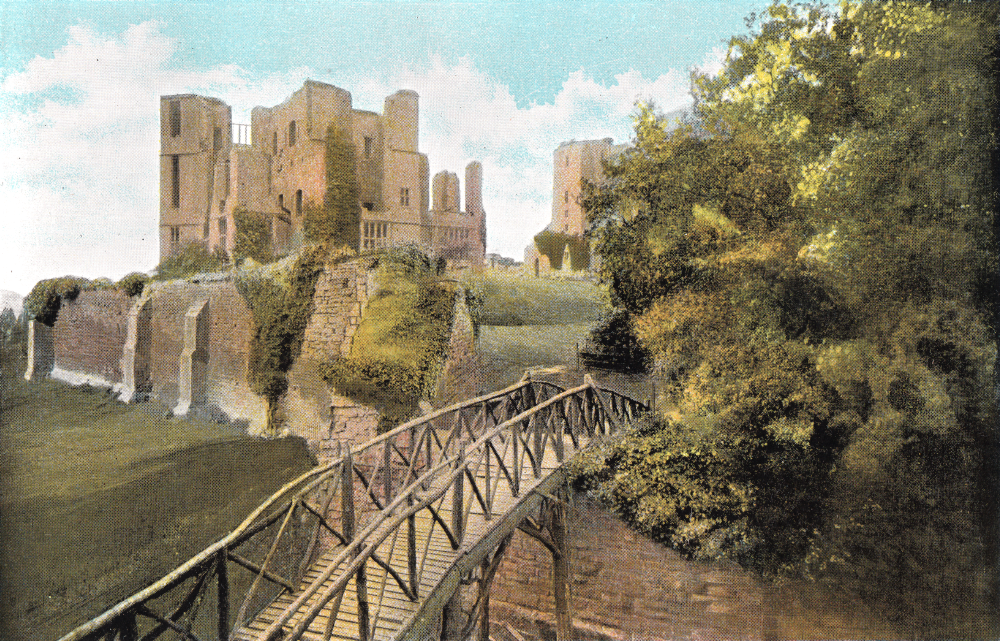
THE RUSTIC BRIDGE, KENILWORTH. The
bridge leads to the ruins of Mortimer's Tower, which probably derives its name
from Sir John Mortimer, who was imprisoned here in the reign of Henry V. Our
picturesque subject presents another aspect of Leicester's Buildings, adjoining
which are the remains of the White Hall and Presence Chamber. Numerous other
portions of the famous old ruins will be found interesting the dungeons under
the Strong Tower, the Winding Staircases, Leicester's Buildings, and the Garden,
which was the scene of the duel between Leicester and Tressilian.
|
Original |
The Ford,
Kenilworth.
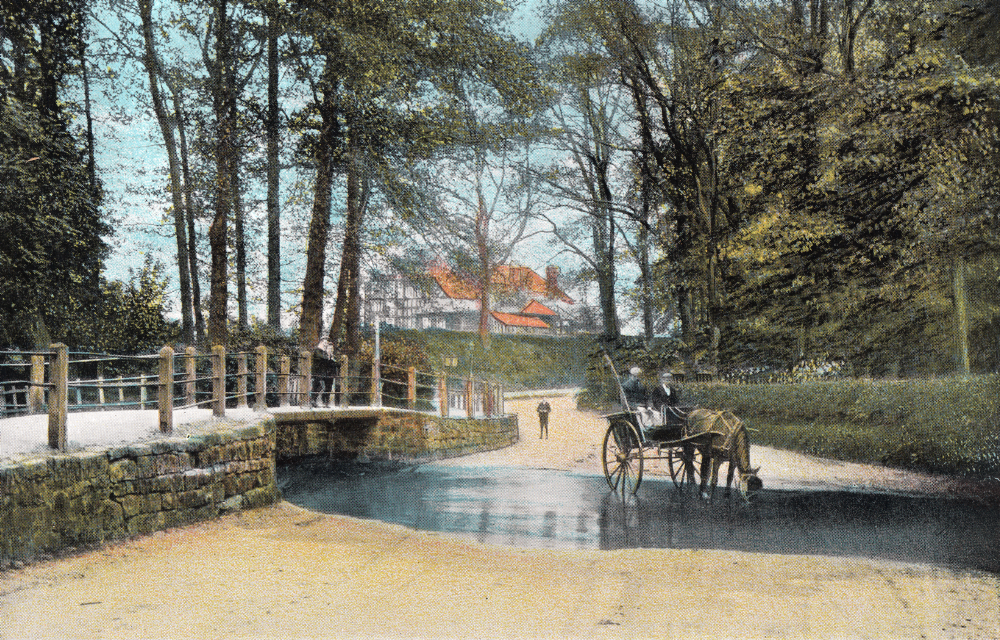
THE FORD, KENILWORTH. This charming rustic
scene is formed the Inchford Brook, which issues from a shady dell, where its
banks are fringed by shapely oaks and beech. It ripples across the roadway and
continues its course across the open fields. One or two interesting relics may
be found in Kenilworth ; thus on the Warwick Road is a small Elizabethan house,
hearing a tablet, on which is carved a bear with ragged staff, and initials R. L.
undoubtedly one of the Castle lodges. There are also remains of two stone
bastions, formerly connected by a drawbridge, by means of which the moat was
crossed in ancient times.
|
Original |
Stoneleigh Abbey.
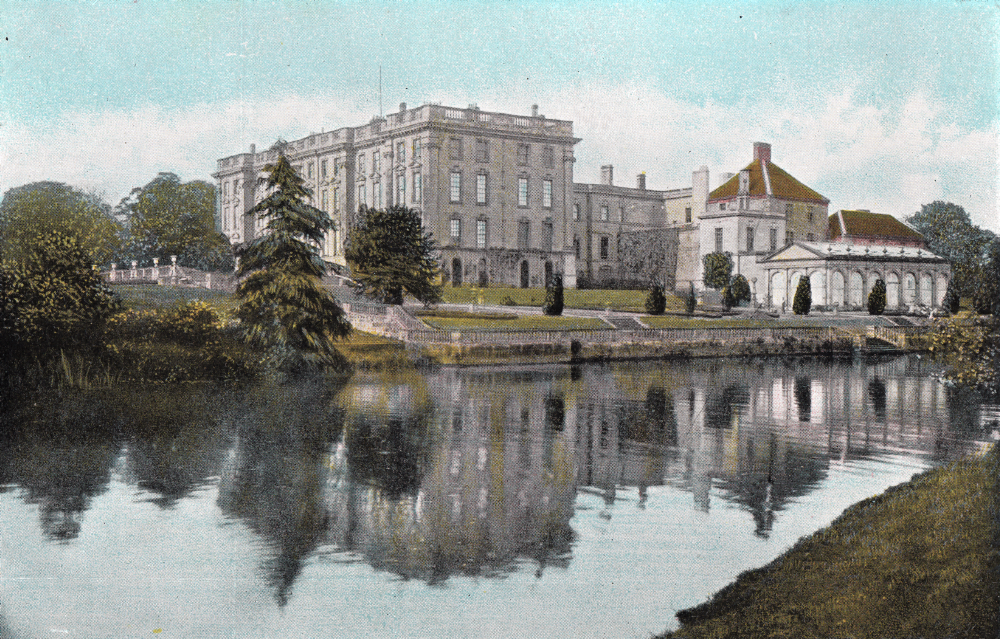
STONELEIGH ABBEY is the residence of
Lord Leigh, and is surrounded by beautiful parkland scenery that would be
difficult to surpass. Through the grounds, tinder a most handsome marble
bridge, the River Avon threads its sinuous course, and as we languorously glide
on its shimmering surface, through leafy archways formed by overhanging
foliage--turning first this way and then that the noble mansion is brought
into view. Nature has been very bountiful here, and her lovers will find much
in which to delight.
|
Original |
The Three Spires,
Coventry.
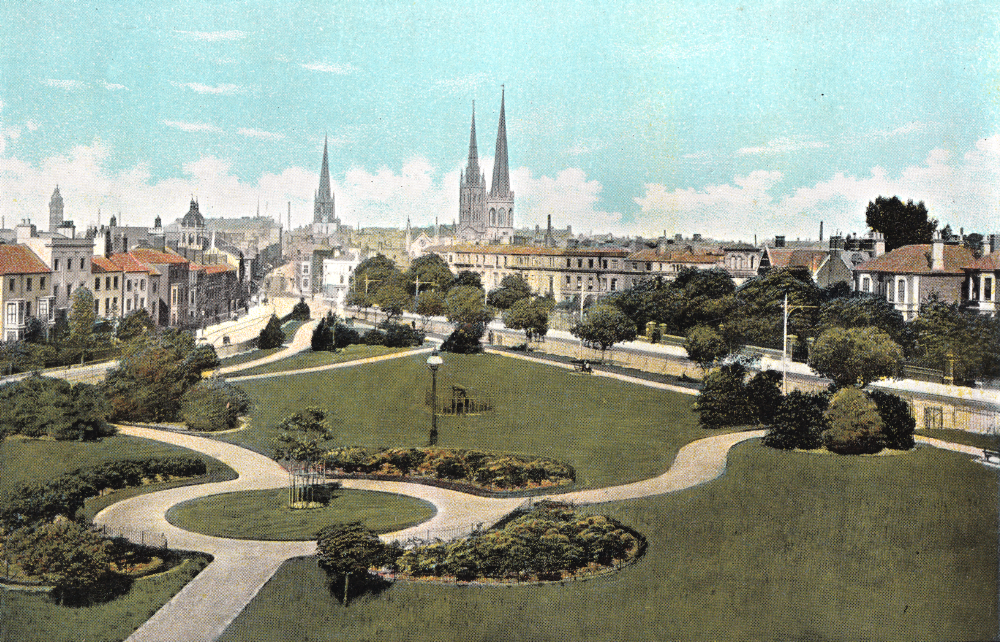
THE THREE SPIRES, COVENTRY. Tennyson, as he
"waited for the train," seems to have been impressed with this view,
and there he " shaped the city's ancient legend " the story of Lady
Godiva. Many relics of the past remain quaint and gabled half-timber houses,
old entrance gates, Cathedral ruins, &c. which bring before us some
interesting episodes in the history of Coventry. Shakespeare, in Richard II.,
describes the famous duel between the Duke of Hereford and the Duke of Norfolk;
Mystery Plays were acted in the narrow streets; Mary, Queen of Scots, was a
prisoner within its walls.
|
Original |
St. Michael's Church,
Coventry.
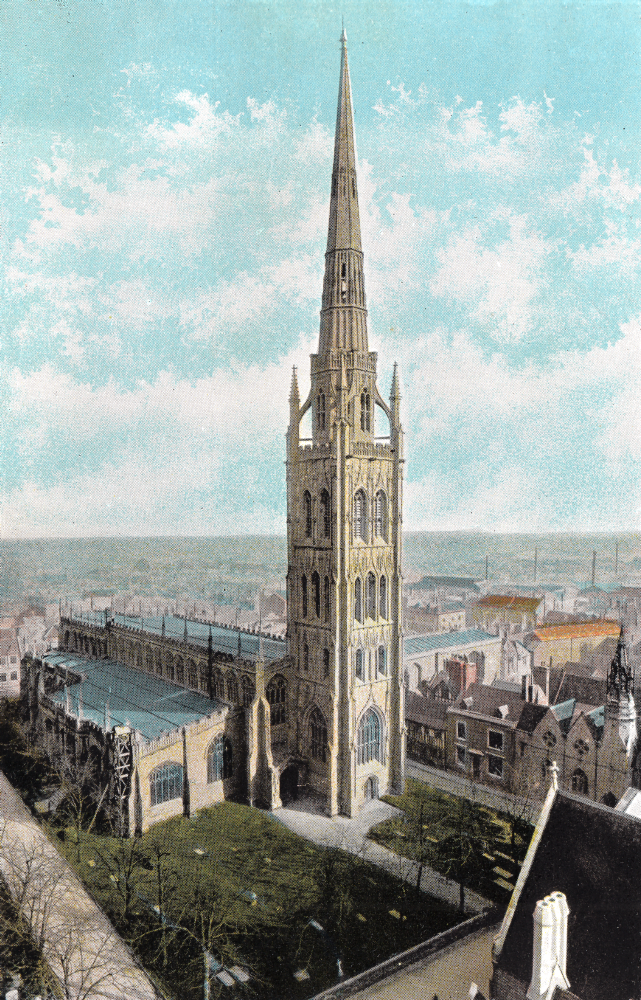
ST. MICHAEL'S CHURCH, COVENTRY. This is the
principal ecclesiastical structure in Coventry, and as a parish
church claims the first place in England. The tower is beautifully
ornamented with carving and windows, and is surmounted by a most
graceful, fluted spire, supported by flying buttresses, the whole
rising 303 feet. The interior is handsome, and the pillars and loft
arches in the Perpendicular very imposing and noble-looking. The
stained glass windows also form an interesting feature.
|
Original |
St. Mary's Hall,
Coventry.
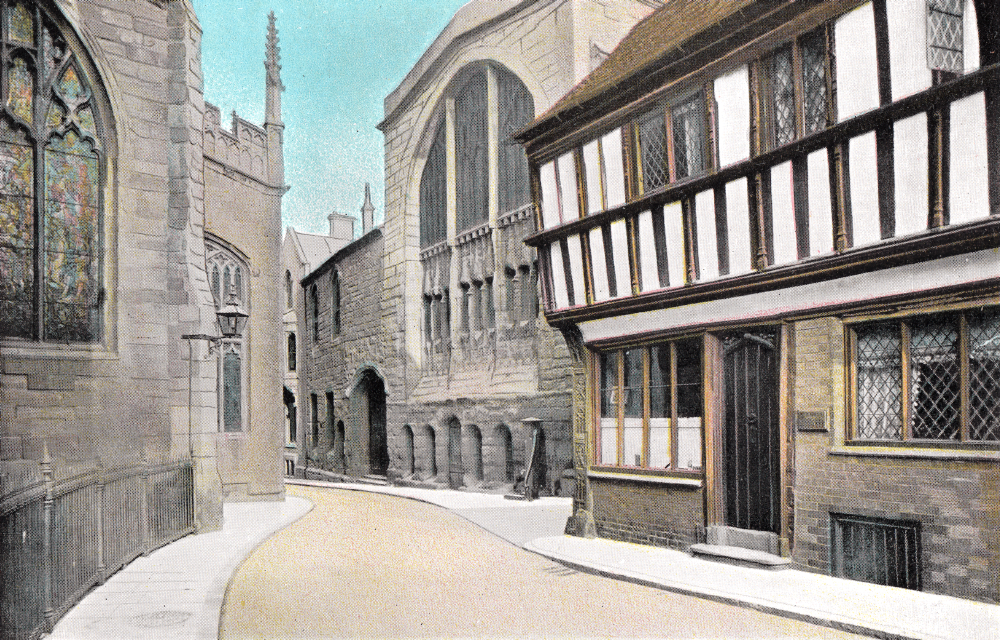
ST. MARY'S HALL, COVENTRY. This, the stone building to
the right of the picture, is rich in curious carving, antiquities, and
paintings, and a vast collection of muniments and literary treasures
has accumulated here since its erection in the time of Henry VI, In the
banqueting hall, where princely entertainments were given, is a fine
stained glass window, representing kings and heraldry, and underneath
is a celebrated piece of old tapestry of exquisite workmanship. The
stocks which were used for the punishment of offenders until 1865, have
been removed from the Market Place, and may now be seen inside the
gates. There is a fine crypt under the hall.
|
Original |
Ford's Hospital.
Coventry.
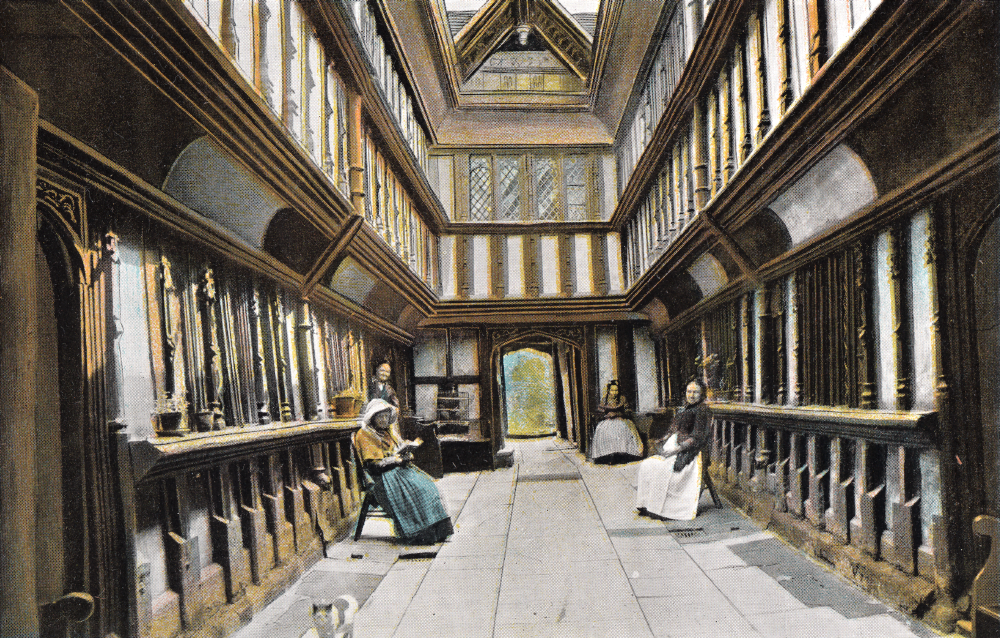
FORD'S HOSPITAL, COVENTRY. Our illustration depicts
one of the most interesting primitive relics to be found in
the country. It provides accommodation for seventeen alms-women,
and there is a similar institution for men known as the Bablake
Hospital. The structure is a splendid example of timber-work, and its
frontage contains three large projecting gable windows,
embellished with elaborate carving and other ornamental work. It
affords a quaint, peaceful haven of rest for its occupants in the
evening of life.
|
Original |
|
"You would not let your
little finger Lady
Godiva.
Lady Godiva
ache for such as these?"
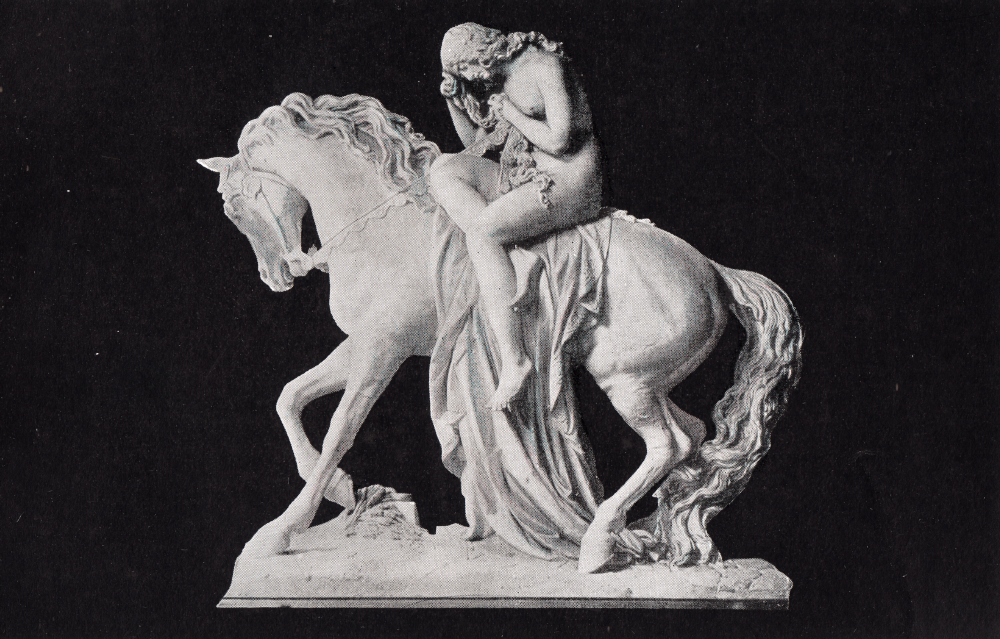
LADY GODIVA. The legend of Lady Godiva dates back to
about 1020, at which time the people of Coventry, being oppressed with
such heavy taxation, were constrained to appeal to the Countess, who
interceded with Leofric. According to Tennyson, he replied in the words
quoted above, but the Countess was persistent, and said : "But prove me
what it is I would not do," and the Earl, with rough brutality, gave
answer: "Ride you naked through the town, and I repeal it." Godiva,
with self-sacrificing devotion, accepted the conditions and set the
people free.
|
Original |
Peeping Tom.
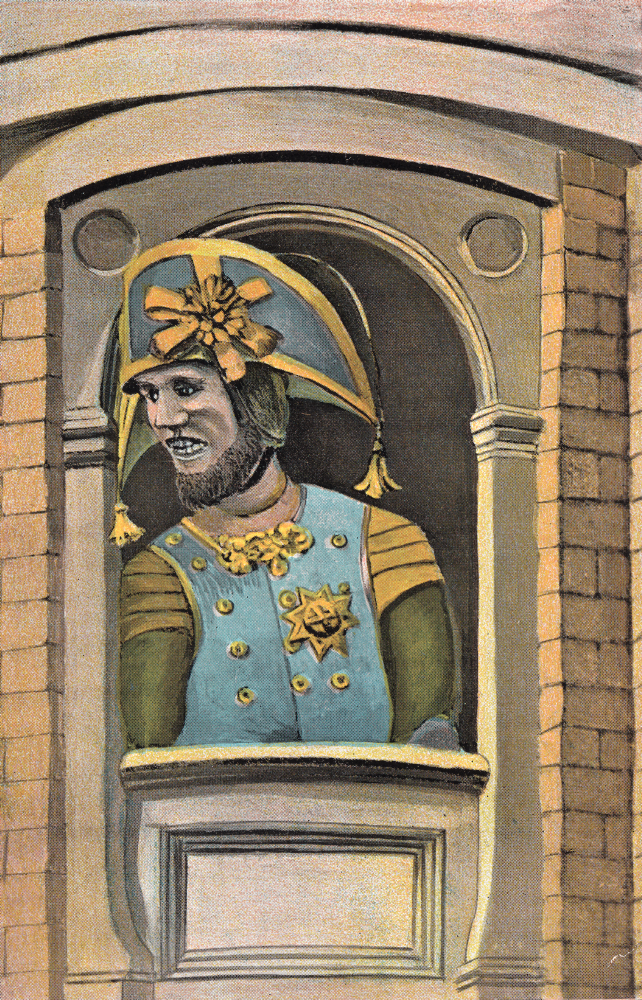
PEEPING TOM. The Story of Lady Godiva would not be
complete without relating its consequences to Peeping Tom. The
Countess before riding forth, made a request to the people that "no
foot should pace the street, no eye look down," but one knave, filled
with overpowering curiosity, bored a hole through his shutters to peep,
but with dire results, for in the words of Tennyson:
"His eyes, before they had their will,
Were shrivelled into darkness in his head,
And dropped before him."
|
Original |
The Long Avenue,
Coventry.
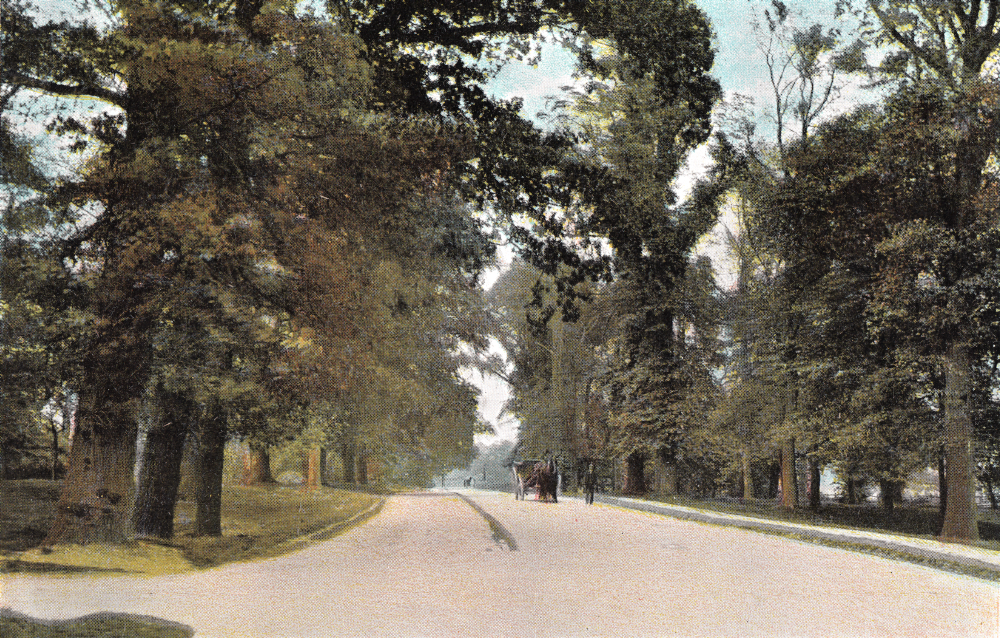
THE LONG AVENUE, COVENTRY Besides being noted for its
quaintness and historical associations, Warwickshire is also noted for
its sylvan beauty, and many lovely country lanes may be found,
especially in the neighbourhood of Stoneleigh Abbey. Our subject is the
well-kept gently undulating road to Kenilworth, and in places the rich
foliage forms a sheltering bower, through which the sun can scarcely
penetrate except to cast fantastic shadows. About half-way is Gibbet
Hill, where evil-doers in the past have paid the extreme penalty.
|
Original |
George Eliot's Birthplace.
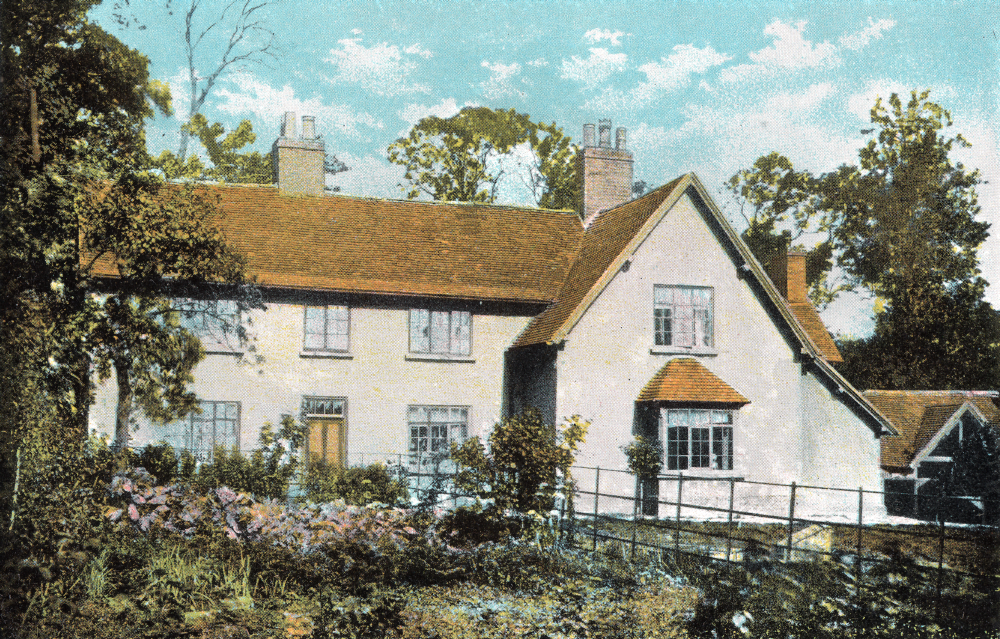
GEORGE ELIOT'S BIRTHPLACE. The South Farm at Arbury,
near Nuneaton, is a homely farmstead on the south side of Arbury Park,
within a mile of Griff House, and about three miles from Nuneaton, and
two from Bedworth. Here it was that Mary Ann Evans was born on November
19th, 1819, but before she reached her seventh month was taken to
Griff, where her father, and subsequently her brother, lived for many
years as agents to the Newdegate family.
|
Original |
Griff House,
Nuneaton.
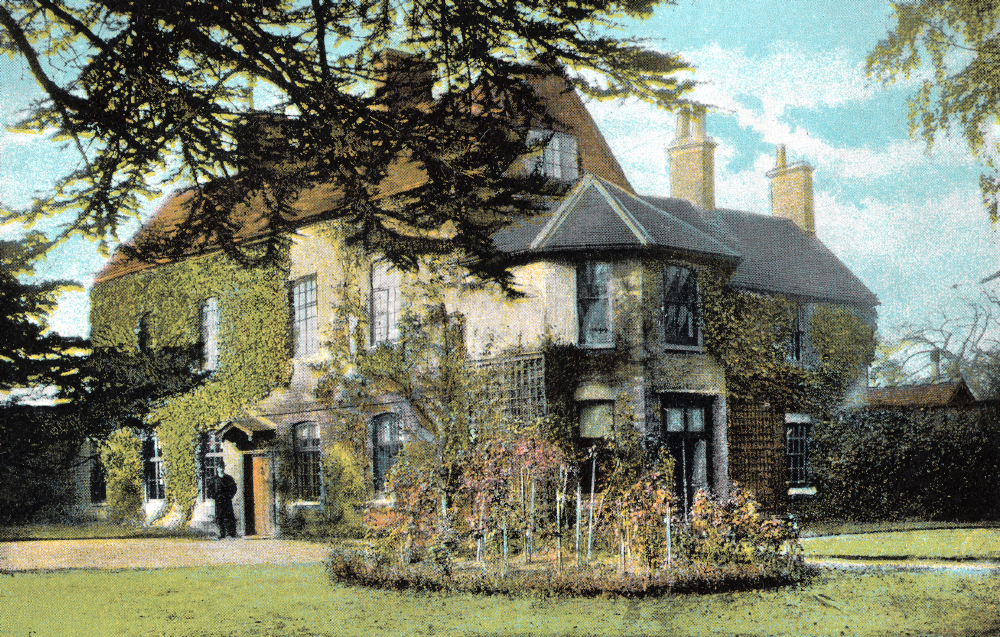
GRIFF HOUSE, NUNEATON, now the Warwickshire County
Council's Dairy School, adjoins the high road at the turning to Arbury
Lodge, and right in the heart of Griff Village. This lovely old house
was George Eliot's home for twenty-three years. From it she attended
school, first at Chilvers Coton, then Nuneaton, and finally Coventry.
On the timbers in the garret are carved tier own name and that of her
brother Isaac Evans, who continued to reside there till his death.
|
Original |
Griff Hollows,
Nuneaton.
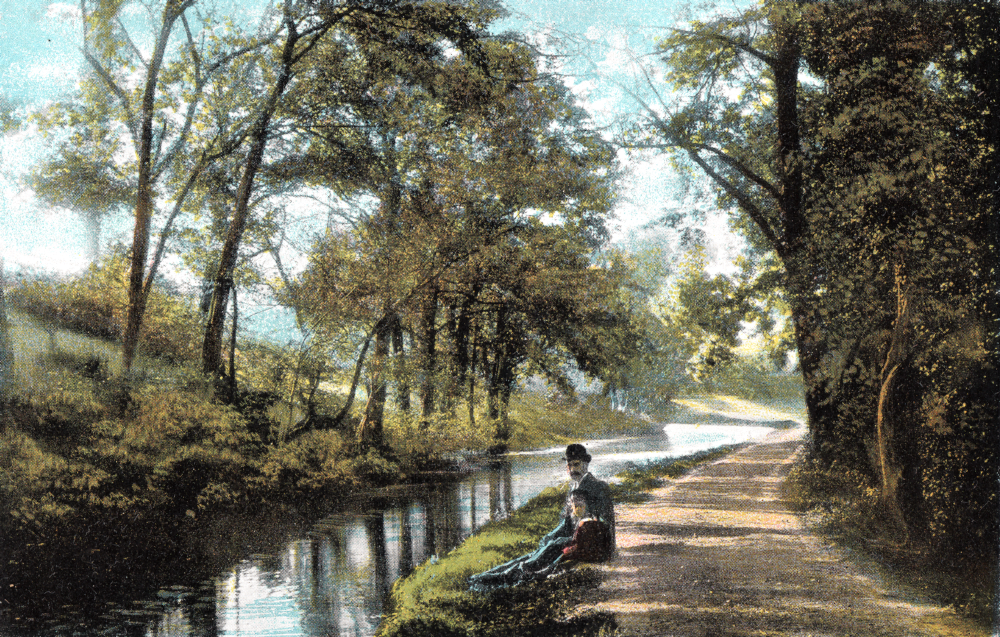
GRIFF HOLLOWS, NUNEATON, is less than a mile from Griff
House, on the way to Nuneaton, and really an arm of the Coventry Canal,
over which the road passes, but it has for the George Eliot enthusiast
an abiding interest as "Red Deeps," whither Maggie and Tom Tulliver
came to fish, who were none other than the novelist herself, and her
brother Isaac, to whom reference is made on another page.
|
Original |
Chilvers Colon Church.
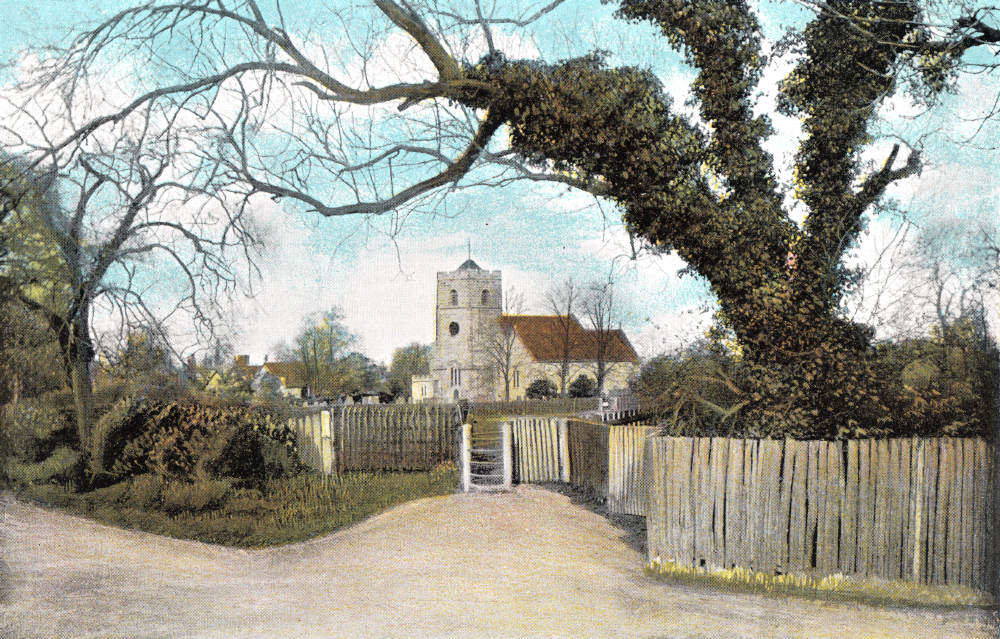
CHILVERS COTON CHURCH, as seen to the right-hand side of
the main road when travelling from Coventry to Nuneaton, also from the
railway embankment, the famous "Shepperton" Church of George Eliot's
"Scenes of Clerical Life," with its outside staircase leading to the
children's gallery. In the church-yard is the grave of Emma Gwyther,
the "Milly Barton " of the story; also here lies buried the novelist's
brother. The Vicarage close by was the scene of "Caterina's" death, as
well as the home of "Milly Barton."
|
Original |
Tire Old Mill at Arbury.
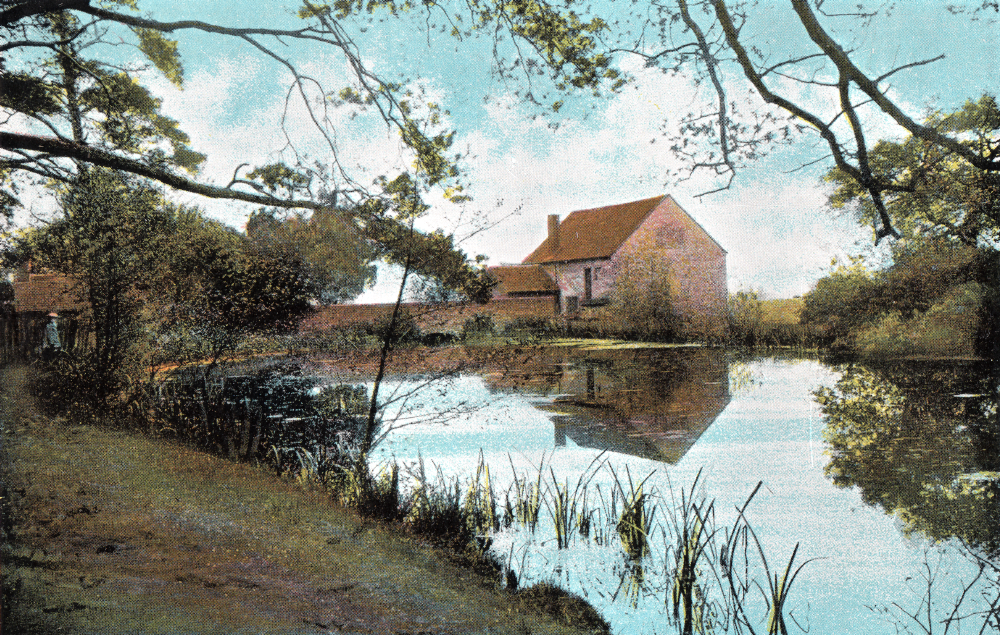
THE OLD MILL AT ARBURY is in itself a charming spot,
apart from the glamour thrown over it by its association with
Warwickshire's gifted novelist. Half-way between Griff House and the
South Farm, and only a short distance off the main road from Nuneaton
to Coventry, it is easy of access, and well worth a visit. Here,
undoubtedly, George Eliot spent many of the happiest days of her
childhood.
|
Original |
Arbury Hall,
Nuneaton.
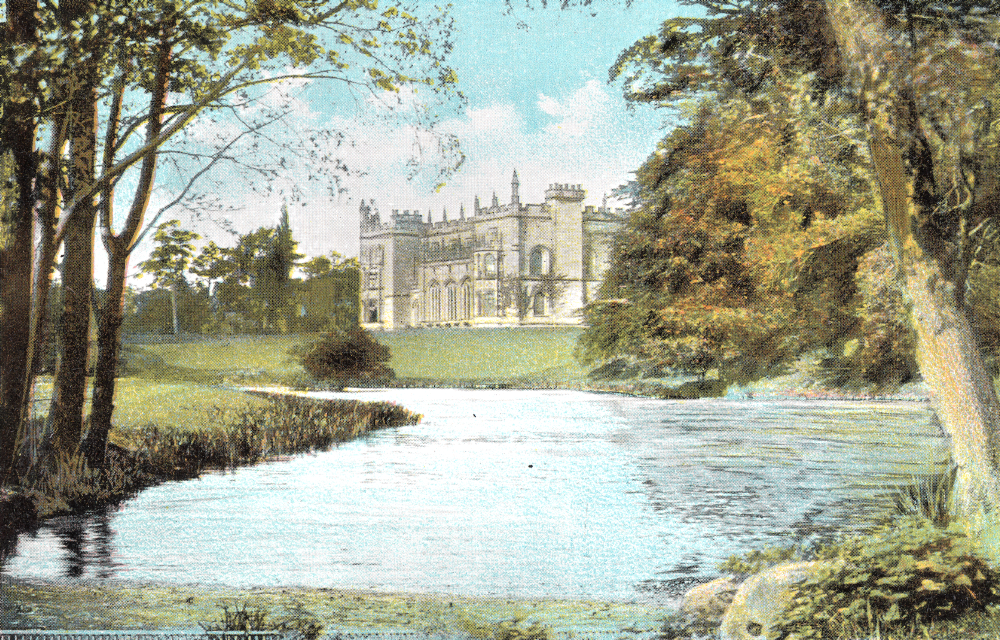
ARBURY HALL, NUNEATON, is one of the most imposing
residences in the county. Rebuilt by Sir Roger Newdegate, the original
of "Sir Christopher Cheverel" in "Scenes of Clerical Life," Arbury
Hall, or, to use George Eliot's title, "Cheverel Manor," is a charming
spot. Surrounded by glorious trees, on an exquisite grassy knoll, with
ornamental waters and acres of park stretching far and wide, its
situation is ideal. Arbury was the scene of "Mr. Gilfit's Love
Story."
|
Original |
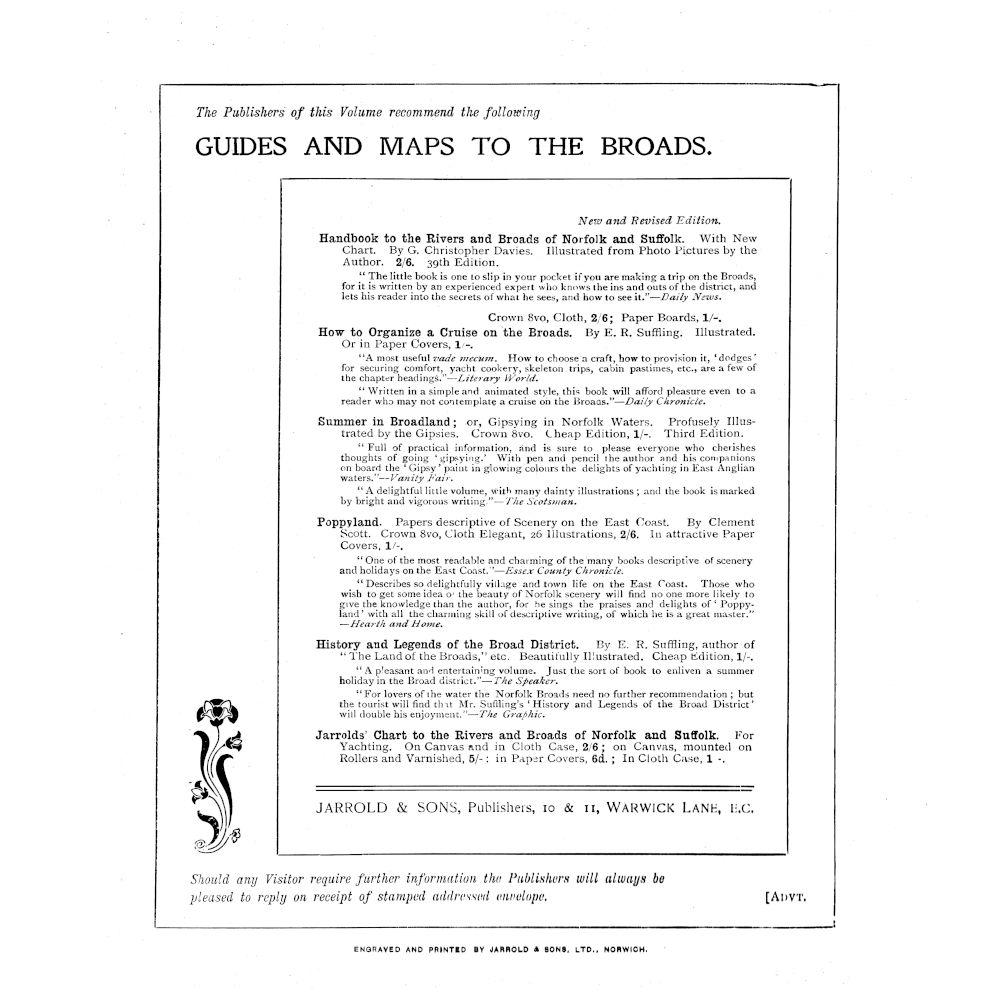
|
Original |
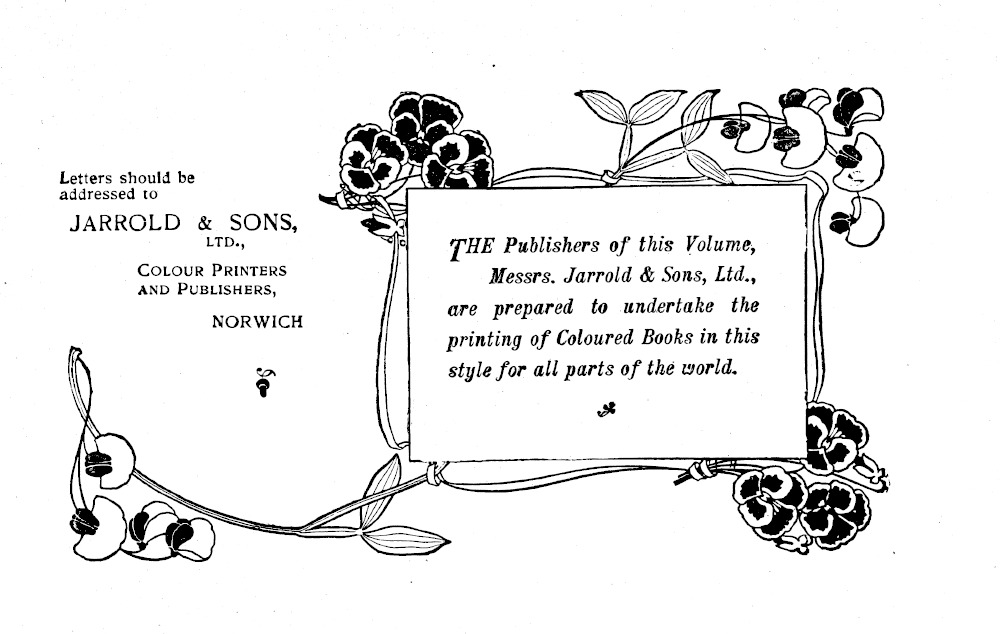
|
Original
|
|